Special Report
Hardest Law Schools to Get Into

Published:
Last Updated:

Working as a lawyer is one of the most prestigious and high paying jobs in America. Prospective attorneys must complete law school and pass the bar exam, but to really stand out among their peers, these students will often aim to get into some of the nation’s most revered law schools to pad their resume and make connections with distinguished alumni.
While many prospective students apply to these exclusive schools, just a fraction get in. Across all American Bar Association accredited law schools, just 35.5% of applicants are accepted. For many of the most exclusive law schools, the acceptance rate is less than half that.
To determine the hardest law schools to get into, 24/7 Wall St. created an index of the acceptance rate, median undergraduate GPA, and median LSAT score from the over 200 American law schools accredited by the American Bar Association. Data on acceptance rate was calculated from data on applications and offers for admittance for the fall 2019 semester from the ABA and was included in the index. Data on the median undergraduate GPA and median LSAT score for the incoming first-year class in the fall 2019 semester also came from the ABA and were included in the index. Supplemental data on the percentage of graduates who took the bar exam for the first time and passed in 2019, and the percentage of the graduates of the Class of 2018 who were unemployed in 2019 also came from the ABA.
To be an exceptional law school candidate, good grades and test scores are critical. Law schools will typically seek applicants with a high grade point average as an undergraduate, as well those with a high score on the Law School Admission Test, or LSAT, which tests the reading, writing, and reasoning skills that are crucial for lawyers. Beyond that, students can set themselves apart by showing their leadership skills through extracurricular activities, academic projects, or work experience.
Attending an exclusive law school can put students on a lucrative career path, even among attorneys. Because of the high level of education needed to be a lawyer, these workers can expect to make more than $100,000 in a given year, a threshold met by just a handful of jobs in the country. These are the 25 highest paying jobs in America.
Click here to see the hardest law schools to get into
Correction: Due to a discrepancy in reporting for Indiana for first-time bar passage as compiled by the American Bar Association, the passage rate listed in the original version of the article for Indiana University Maurer School of Law was substantially lower than it should have been. We have updated that figure based on the value provided by the school and removed a passage in the profile for the school that referenced the incorrect rate.
50. University of Minnesota Law School
> Acceptance rate: 39.1%
> Total 2019 applications: 2,129
> Median undergraduate GPA, first year class: 3.75
> Median LSAT score, first year class: 165
> Bar passage rate: 93.0%
The University of Minnesota Law School, located in Minneapolis, ranks among the 50 hardest to get into nationwide, largely because of the academic records of admitted students. In the fall of 2019, the median undergraduate GPA of first years at the school was 3.75, higher than in the vast majority of U.S. law schools. Similarly, the median score on the LSAT — the standardized law school admissions exam — among the same cohort was 165 out of 180, also far higher than average.
[in-text-ad]
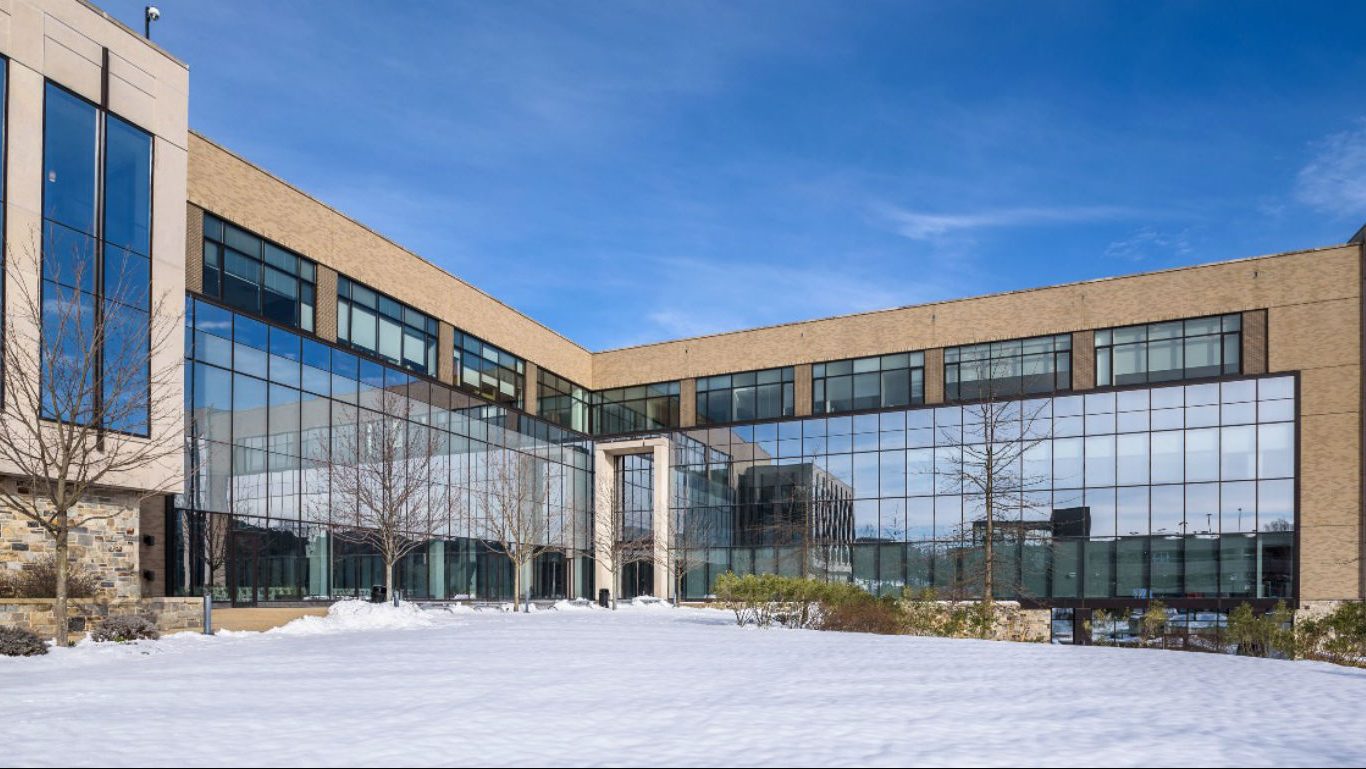
49. Villanova University’s Charles Widger School of Law
> Acceptance rate: 34.2%
> Total 2019 applications: 2,048
> Median undergraduate GPA, first year class: 3.60
> Median LSAT score, first year class: 159
> Bar passage rate: 87.4%
Villanova University’s Charles Widger School of Law, located just outside of Philadelphia, ranks among the hardest law schools to get into in part because its median LSAT score of 159 and median undergraduate GPA of 3.6 are higher than in most other U.S. law schools considered. Graduates of the Widger School of Law tend to be successful on their first bar exam, with 87.4% passing the qualification test on their first attempt, compared with fewer than 80% of first-time exam takers nationwide.
48. University of Illinois College of Law
> Acceptance rate: 36.7%
> Total 2019 applications: 1,304
> Median undergraduate GPA, first year class: 3.70
> Median LSAT score, first year class: 162
> Bar passage rate: 92.5%
The University of Illinois College of Law is a professional graduate school of the University of Illinois at Champaign-Urbana. The school’s acceptance rate of 36.7% makes it slightly less selective than most law schools — the overall acceptance rate across all law schools is 35.5% — but the median undergraduate GPA and LSAT scores among first-year students are especially high compared with other law schools.
Most graduates in the class of 2019 accepted jobs in the state, while a handful accepted positions in California, New York, and foreign countries.
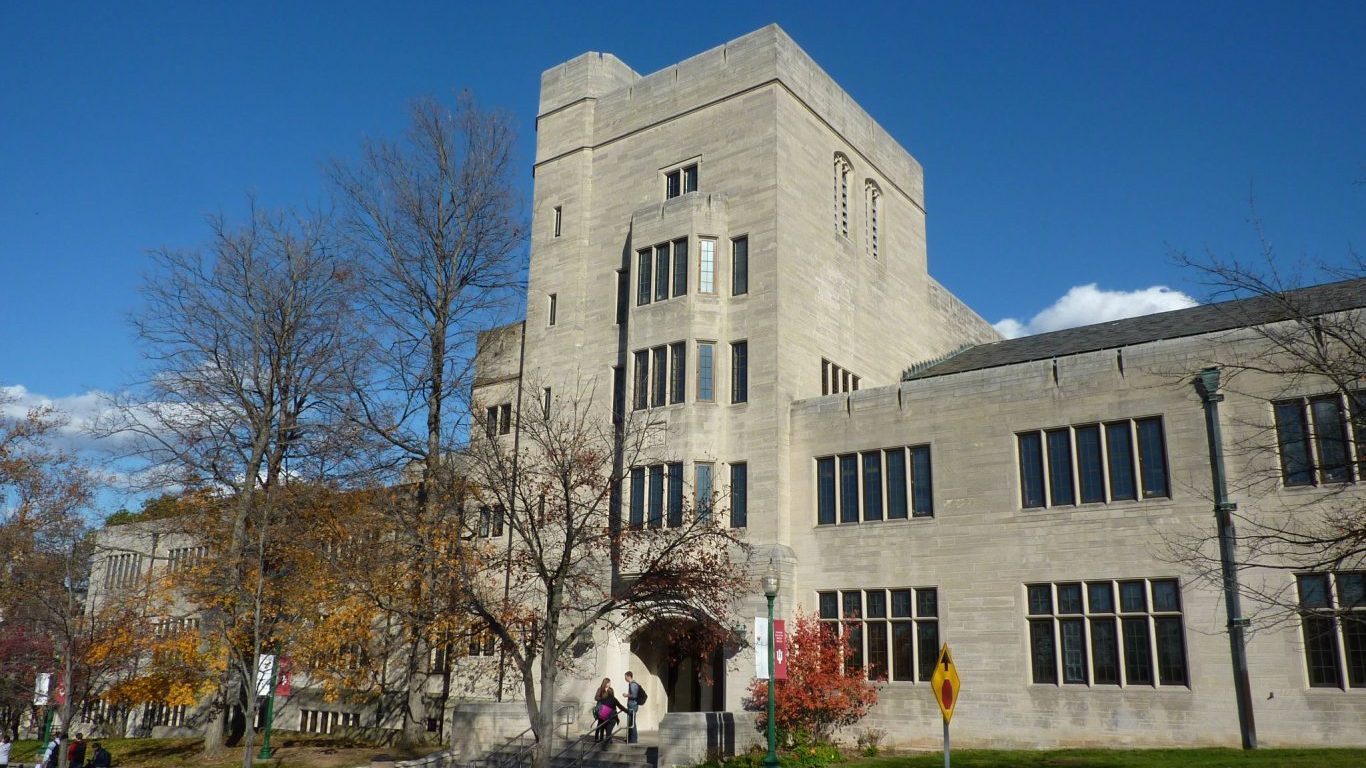
47. Indiana University Maurer School of Law
> Acceptance rate: 37.9%
> Total 2019 applications: 1,790
> Median undergraduate GPA, first year class: 3.79
> Median LSAT score, first year class: 162
> Bar passage rate: 86.1%
Among all 1,790 applicants to Indiana University’s Maurer School of Law, 679 were admitted in the fall of 2019. This 37.9% acceptance rate is slightly higher than the 35.5% rate of the typical law school. The law school ranks among the most competitive to get into because the median undergraduate GPA of fall 2019 first year students was 3.79, the 21st highest in the nation.
[in-text-ad-2]
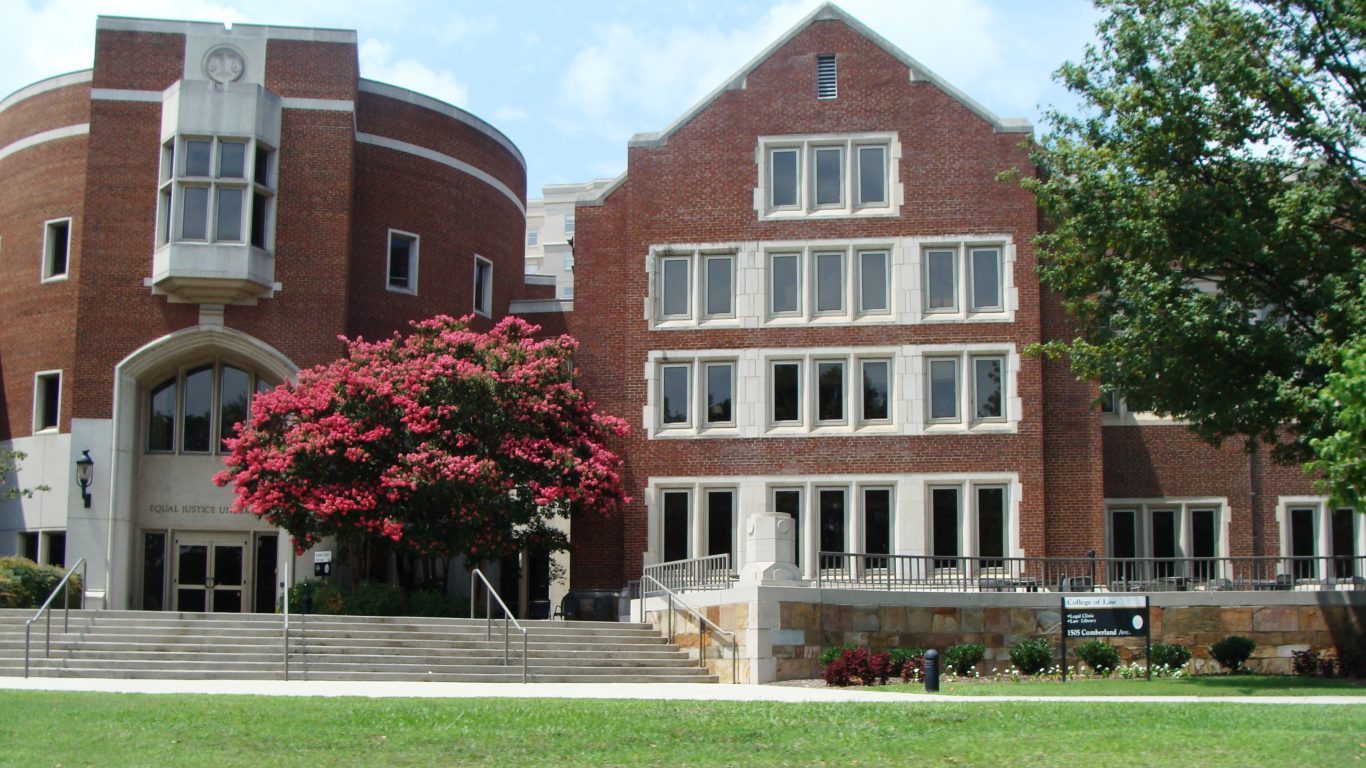
46. University of Tennessee College of Law
> Acceptance rate: 34.4%
> Total 2019 applications: 1,042
> Median undergraduate GPA, first year class: 3.65
> Median LSAT score, first year class: 159
> Bar passage rate: 85.6%
The University of Tennessee College of Law in Knoxville ranks among the most selective law schools in the country. More than 1,000 people applied to the school for the 2019 academic year, and the school sent only 358 acceptance letters in response. The 34.4% acceptance rate is lower than those of about 75% of all U.S. law schools.
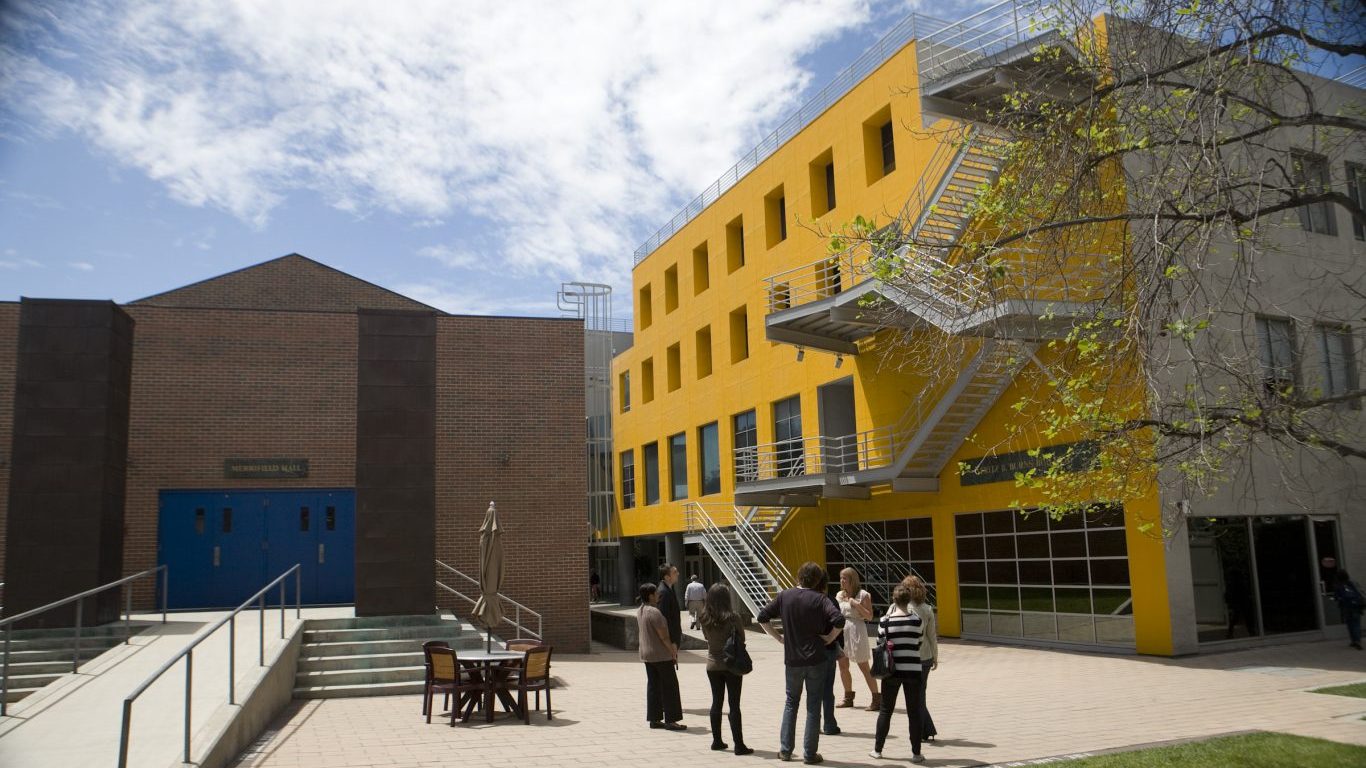
45. LMU Loyola Law School
> Acceptance rate: 33.0%
> Total 2019 applications: 3,802
> Median undergraduate GPA, first year class: 3.57
> Median LSAT score, first year class: 160
> Bar passage rate: 77.7%
Only about one-third of those who applied to Loyola Law School at Loyola Marymount University for the 2019 academic year were accepted — a lower acceptance rate than the vast majority of U.S. law schools. The school’s curriculum is largely focused on public interest offering an immigrant justice clinic and a conflict resolution center, and students are required to provide at least 40 hours of pro-bono service in order to graduate.
[in-text-ad]
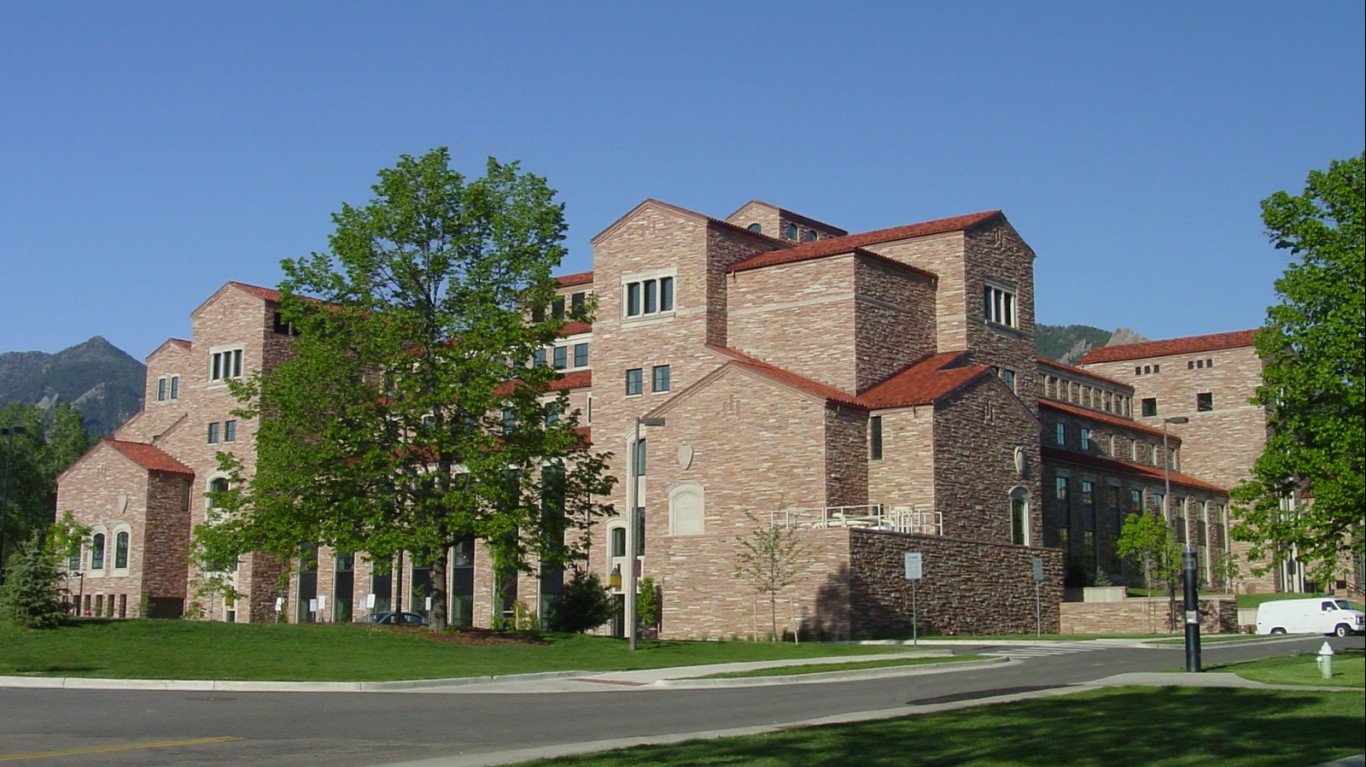
44. University of Colorado Law School
> Acceptance rate: 34.7%
> Total 2019 applications: 3,187
> Median undergraduate GPA, first year class: 3.61
> Median LSAT score, first year class: 163
> Bar passage rate: 87.5%
Students who began attending University of Colorado Law School in the fall of 2019 likely did well on the LSAT. Enrollees had a median score of 163, out of a maximum of 180, one of the highest medians among all accredited U.S. law schools. Graduates are relatively likely to pass the bar exam and go on to find a job. Seven of every eight first-time bar exam takers in 2019 passed the exam, well above the typical first-time passage rate. Those who graduated the University of Colorado Law School in 2018 had an unemployment rate of just 2.6%, well below the 7.3% unemployment rate for all law school graduates that year.
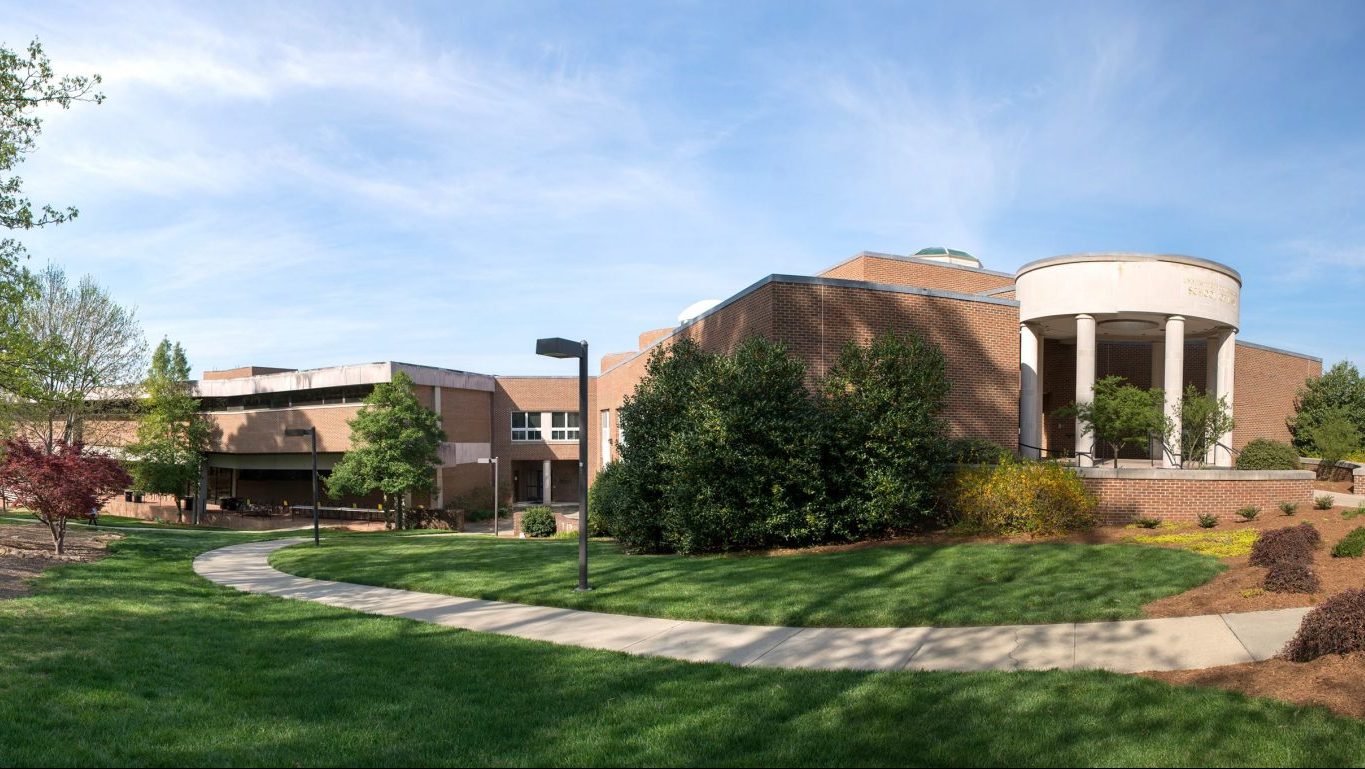
43. University of North Carolina School of Law
> Acceptance rate: 33.9%
> Total 2019 applications: 1,293
> Median undergraduate GPA, first year class: 3.63
> Median LSAT score, first year class: 161
> Bar passage rate: 92.5%
The University of North Carolina School of Law, located in Chapel Hill, is one of the most selective law schools in the country. The school received 1,293 applications for admittance for the 2019 academic year and sent only 438 letters of acceptance.
The school also appears to prepare its students for jobs in law after graduation better than most. Of the 200 first-time takers of the bar exam in 2019, 92.5% passed, a higher passage rate than in all but 21 of the more than 200 law schools accredited by the American Bar Association.
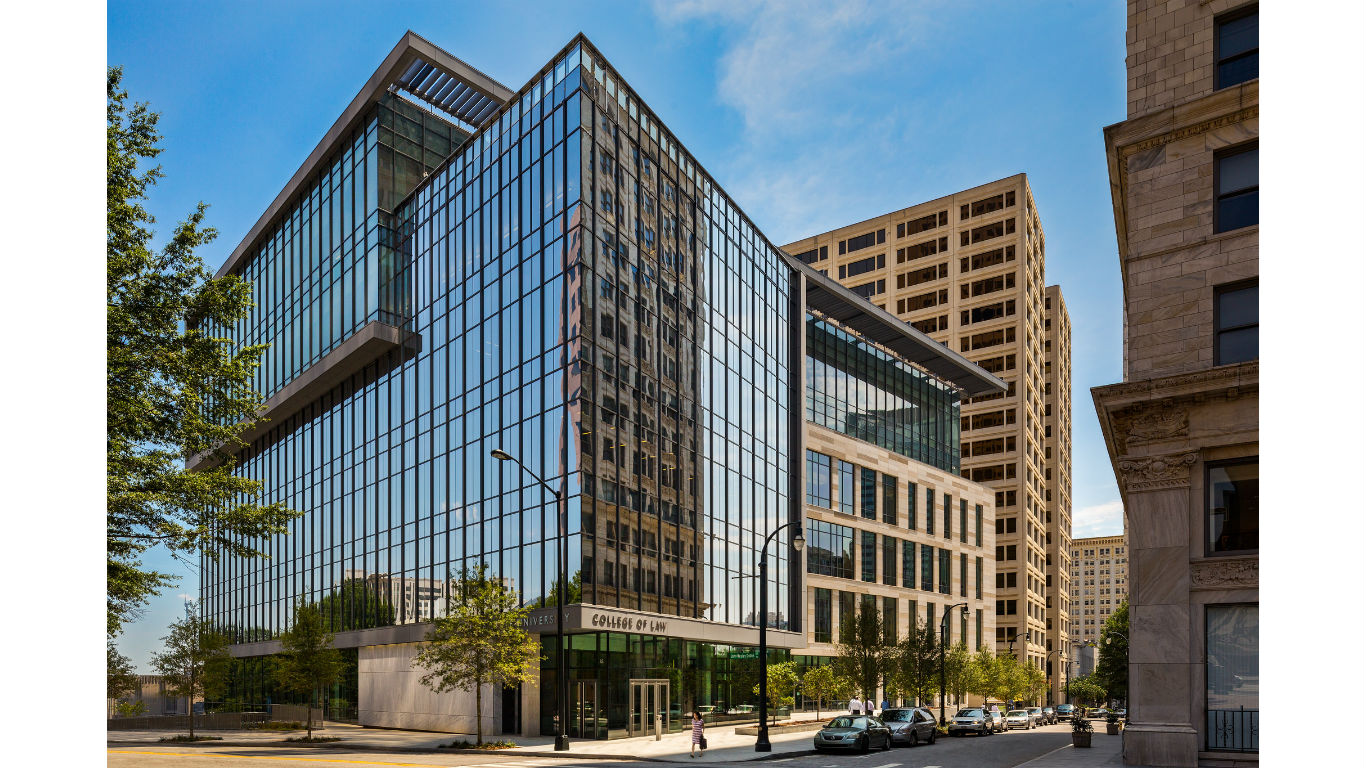
42. Georgia State University College of Law
> Acceptance rate: 29.3%
> Total 2019 applications: 1,710
> Median undergraduate GPA, first year class: 3.51
> Median LSAT score, first year class: 158
> Bar passage rate: 86.9%
Georgia State University College of Law is one of just 36 accredited U.S. law schools to have admitted fewer than 30% of applicants for the fall of 2019. The Atlanta-based law school accepted just 501 of the 1,710 applicants for the fall 2019 class. School graduates tend to fare well on the bar exam as 86.9% of first-time takers in 2019 passed the test, well above the 79.6% first-time passage rate among all first-time takers.
[in-text-ad-2]
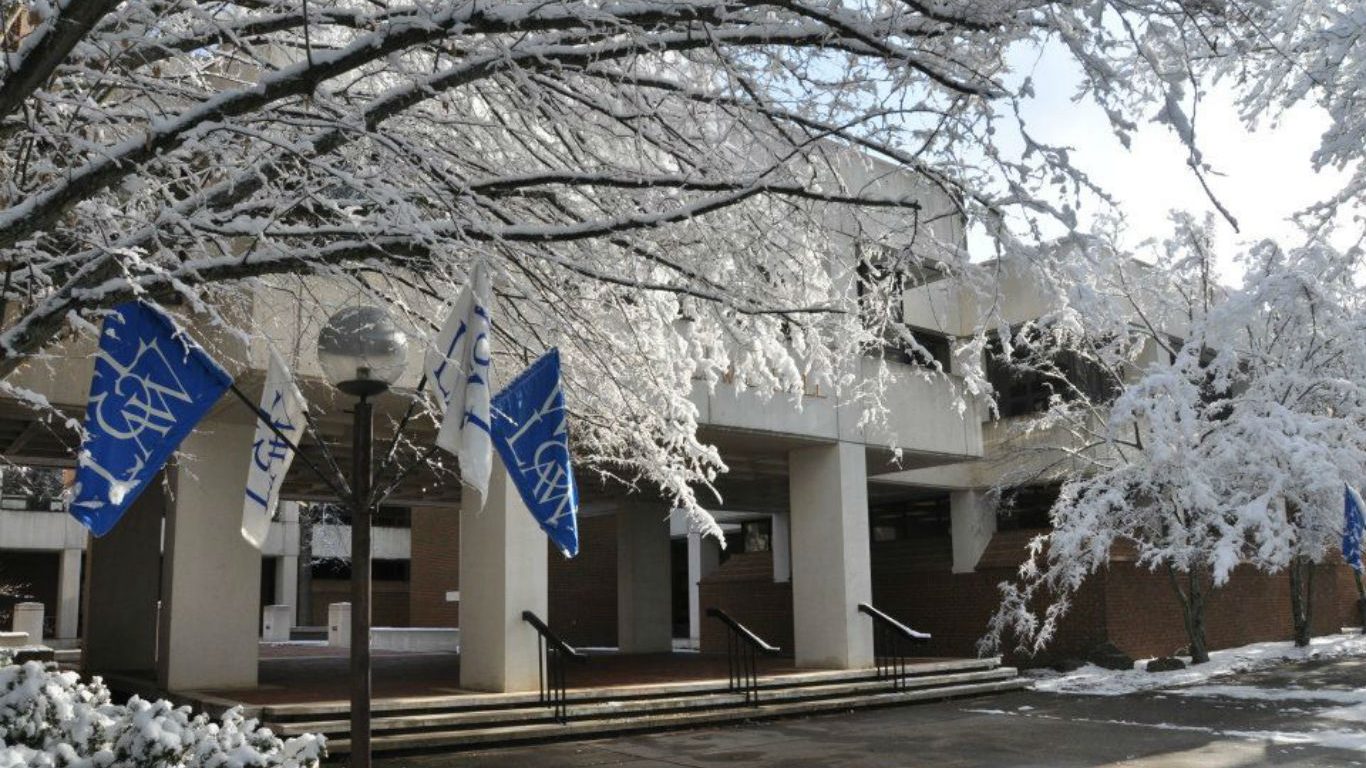
41. Washington and Lee University School of Law
> Acceptance rate: 33.2%
> Total 2019 applications: 2,551
> Median undergraduate GPA, first year class: 3.64
> Median LSAT score, first year class: 163
> Bar passage rate: 89.7%
One of the oldest law schools in the country, Washington and Lee University School of Law, located in Lexington, Virginia, traces its roots back to 1849 and was accredited by the ABA in 1923. Today, the law school is one of only 44 in the United States that accepts fewer than a third of applicants. Additionally, only 33 law schools have a higher median LSAT score for first-year students than Washington and Lee.
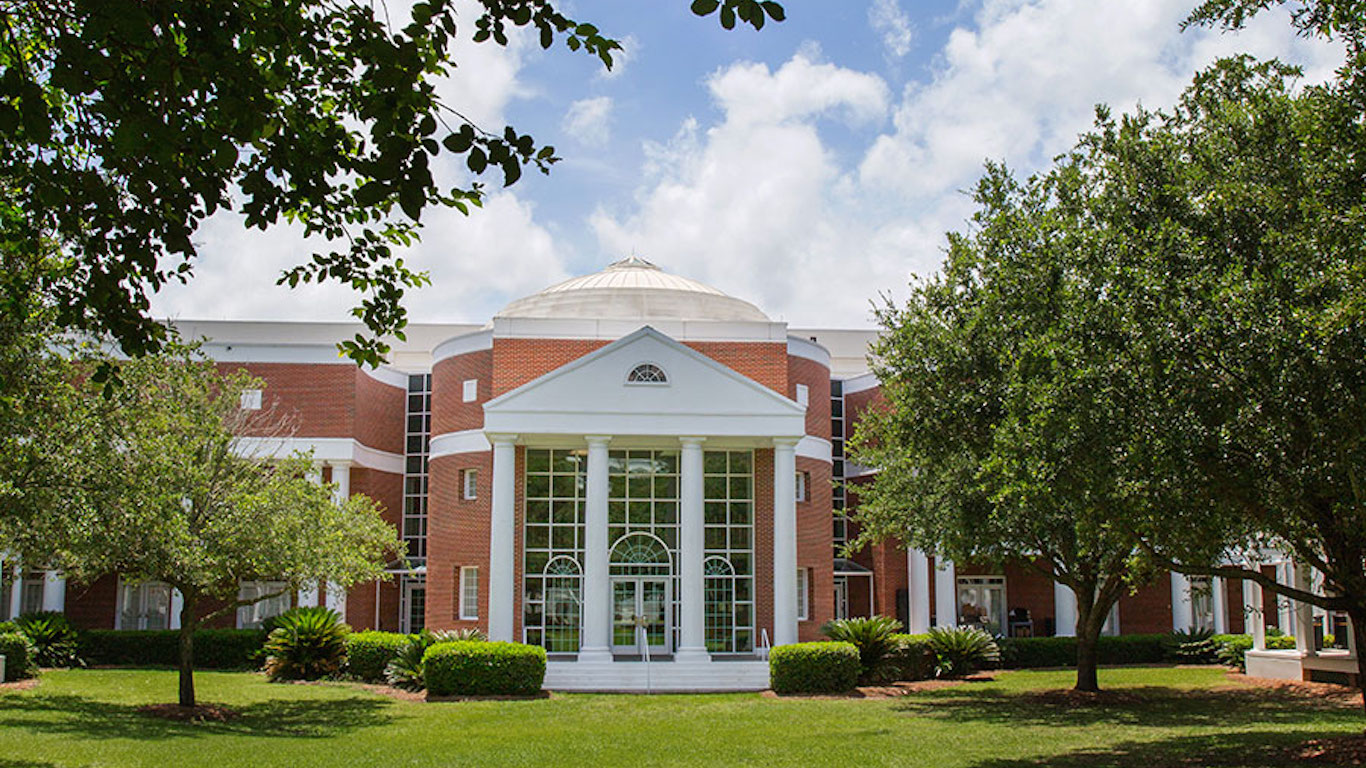
40. Florida State University College of Law
> Acceptance rate: 32.7%
> Total 2019 applications: 1,598
> Median undergraduate GPA, first year class: 3.73
> Median LSAT score, first year class: 160
> Bar passage rate: 86.7%
Florida State University College of Law in Tallahassee is one of only 44 ABA accredited schools that accepts fewer than one-third of all those who apply. Additionally, the median undergraduate GPA for the first year class in 2019 was 3.73, higher than all but 30 other ABA accredited schools.
The school is widely recognized for job placement of alumni, and the unemployment rate among graduates of the class of 2018 is only 3.6%.
[in-text-ad]
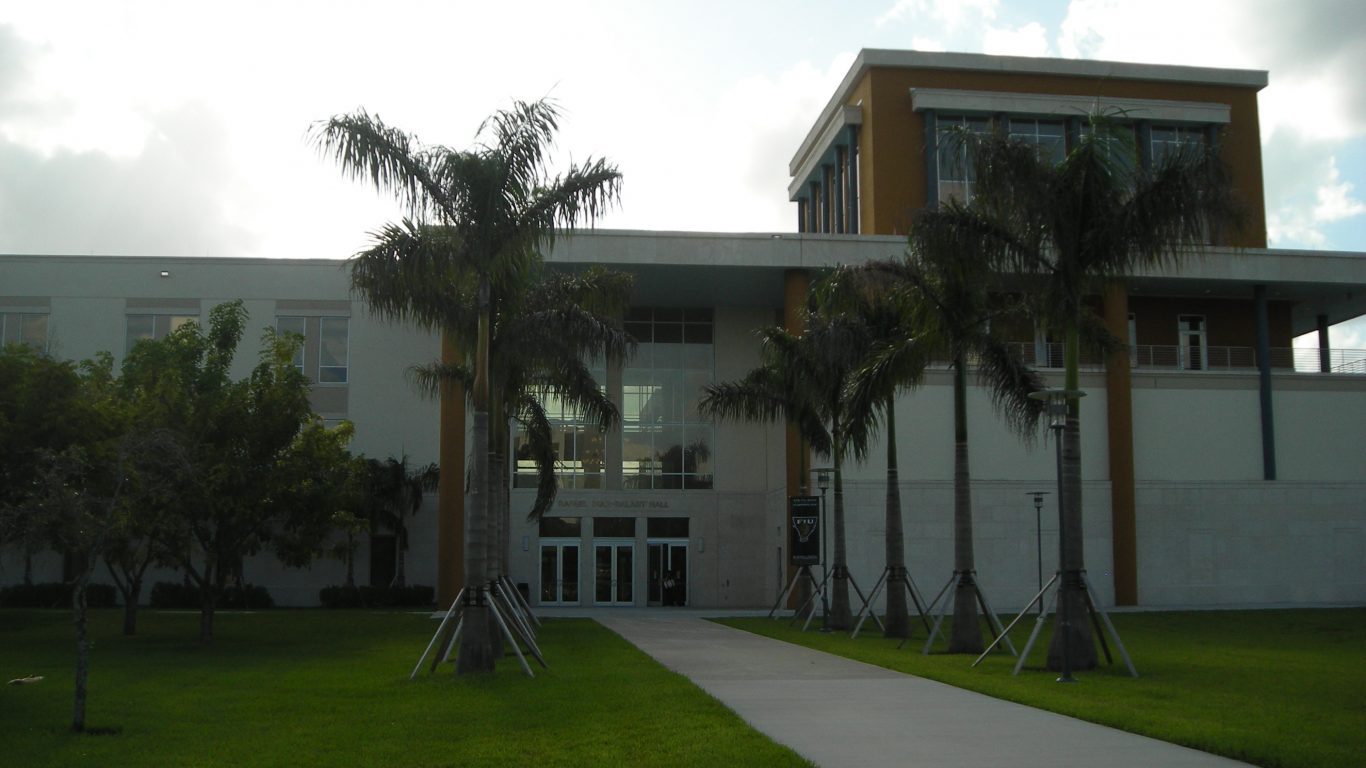
39. Florida International University College of Law
> Acceptance rate: 28.6%
> Total 2019 applications: 1,665
> Median undergraduate GPA, first year class: 3.61
> Median LSAT score, first year class: 157
> Bar passage rate: 94.8%
Florida International University College of Law, located in Miami, is one of the hardest ABA accredited schools in the country to get into, due in large part to its acceptance rate. Only 28.6% of applicants for the 2019 academic year received acceptance letters, a smaller share than in all but 30 other ABA schools.
One of the newest law schools in the country, FIU College of Law was not accredited by the ABA until 2004.
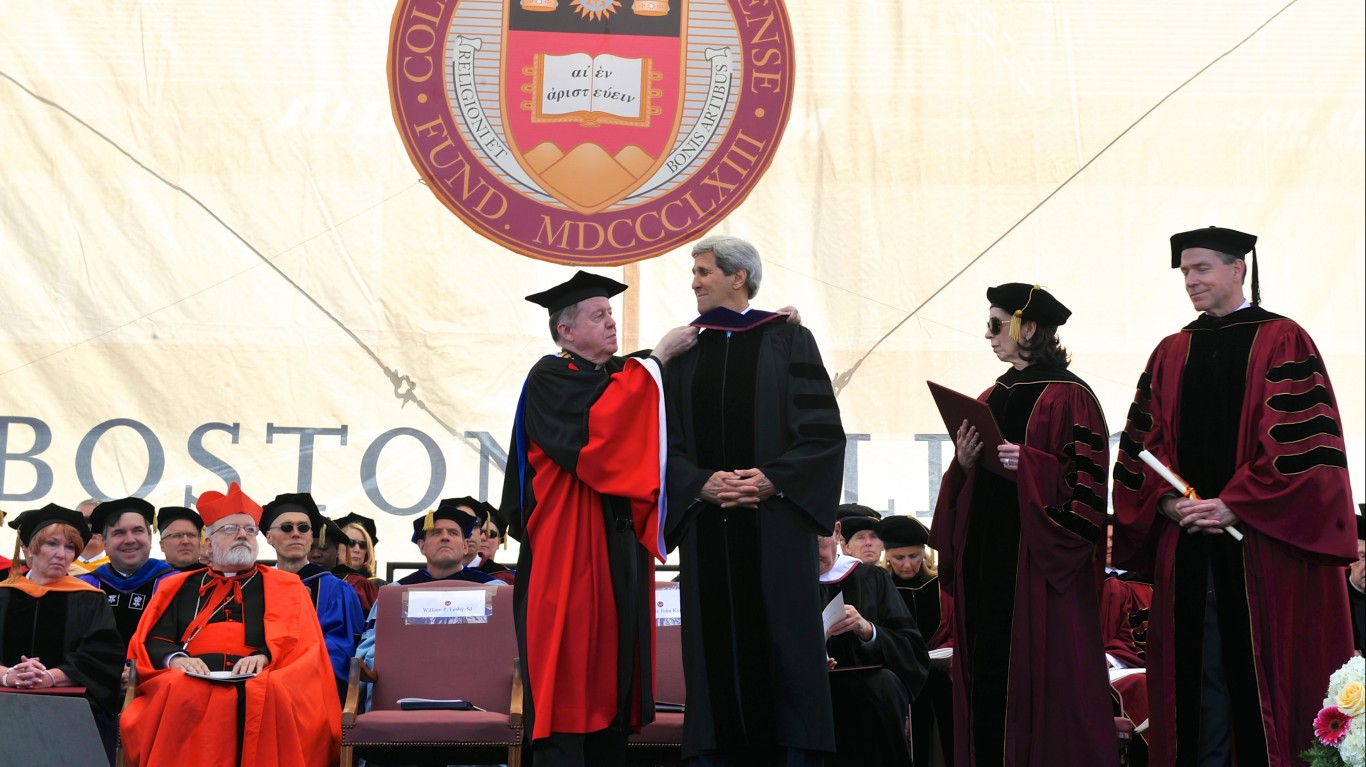
38. Boston College Law School
> Acceptance rate: 31.3%
> Total 2019 applications: 4,717
> Median undergraduate GPA, first year class: 3.64
> Median LSAT score, first year class: 164
> Bar passage rate: 91.5%
Boston College Law School is one of the largest law schools in the United States by total enrollment, with 749 total law students and a 2019 first-year class of 253 students. It is also one of the most selective schools, sending only 1,477 acceptance letters for the 4,717 applications it received.
It also has a relatively strong track record of preparing students for the bar exam as it was one of only 38 ABA accredited schools in 2019 where at least nine in every 10 first-time takers of the bar exam passed.
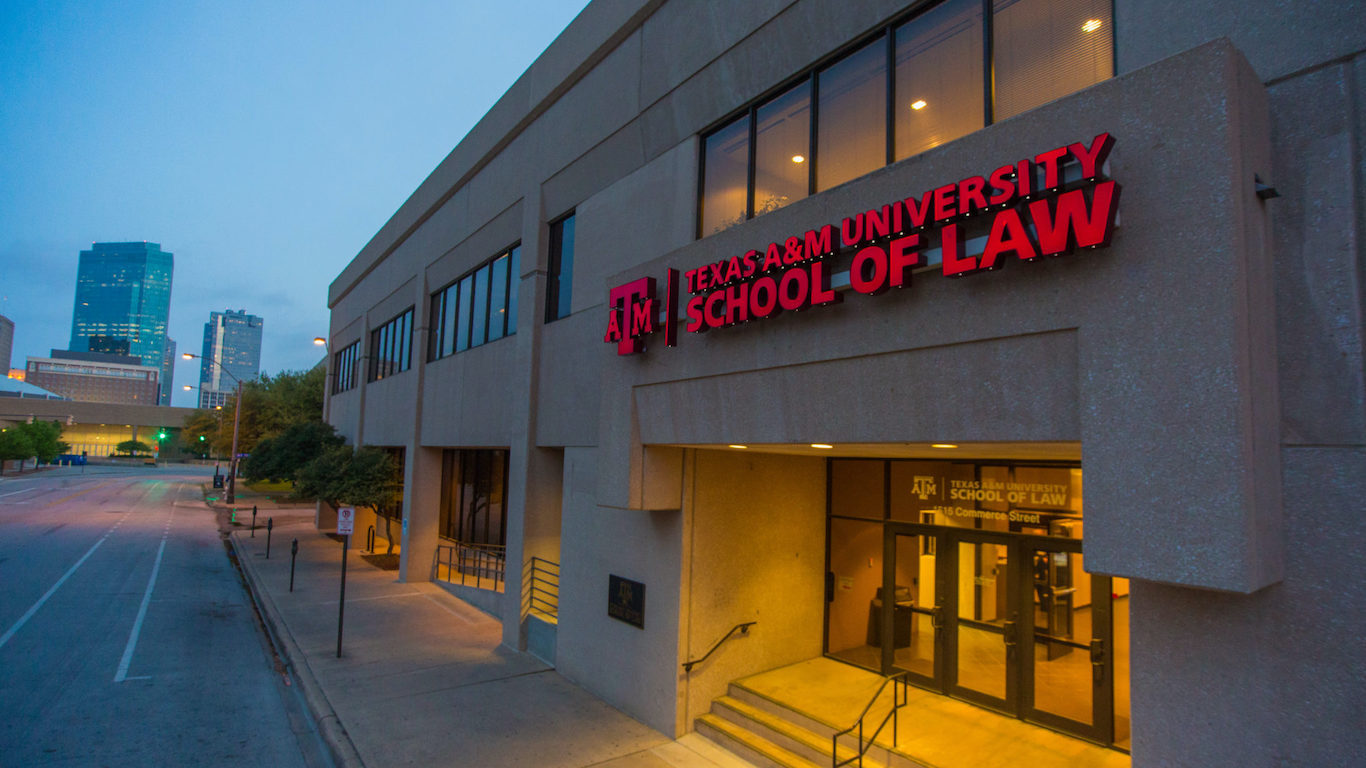
37. Texas A&M University School of Law
> Acceptance rate: 28.7%
> Total 2019 applications: 2,280
> Median undergraduate GPA, first year class: 3.62
> Median LSAT score, first year class: 159
> Bar passage rate: 90.3%
Texas A&M University School of Law accepted only 28.7% of those who applied for the 2019 school year — one of the lower acceptance rates of any U.S. law school.
Texas A&M University Law School is located in Fort Worth, Texas. The school was first accredited in 1994 and was formerly known as the Texas Wesleyan School of Law.
[in-text-ad-2]
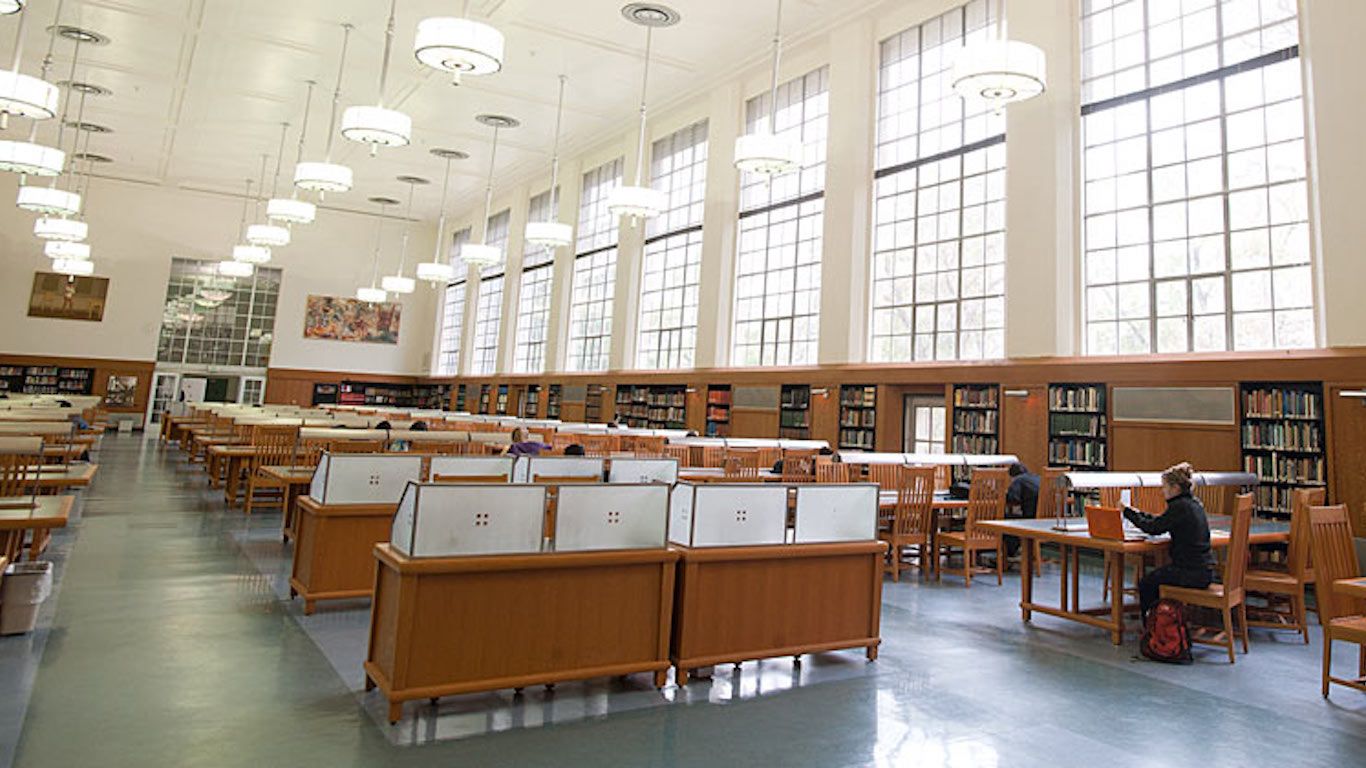
36. University of California-Davis School of Law
> Acceptance rate: 29.4%
> Total 2019 applications: 3,103
> Median undergraduate GPA, first year class: 3.61
> Median LSAT score, first year class: 162
> Bar passage rate: 84.5%
University of California-Davis School of Law is one of four law schools in California’s public university system to rank on this list. One of the most selective law schools in the country, the school has a strong track record of job placement following graduation. The unemployment rate among the class of 2018 is just 3.4%, lower than the comparable rate for the same class in the vast majority of law schools nationwide.
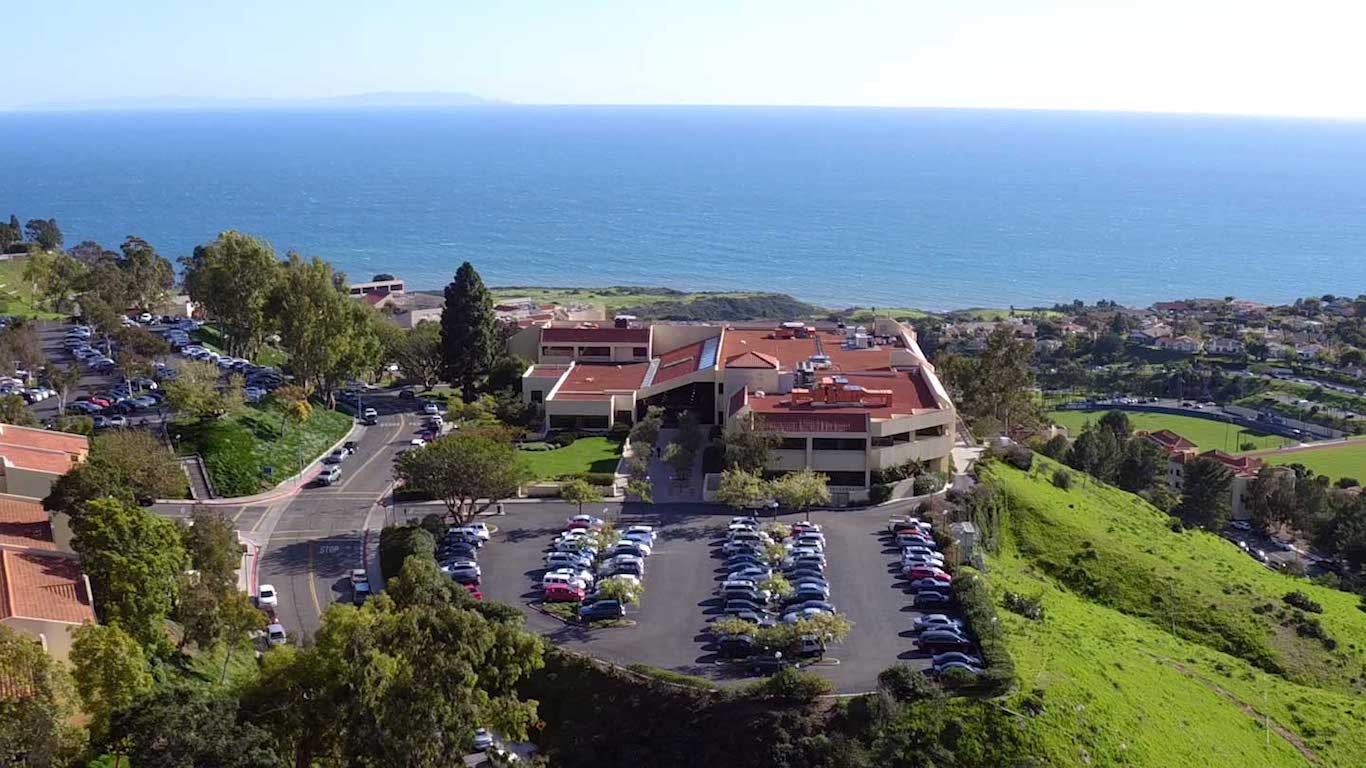
35. Pepperdine University Caruso School of Law
> Acceptance rate: 29.8%
> Total 2019 applications: 3,006
> Median undergraduate GPA, first year class: 3.66
> Median LSAT score, first year class: 161
> Bar passage rate: 82.4%
Located in Malibu, California, Pepperdine University Caruso School of Law was accredited by the ABA in 1972. It is one of the larger law schools in the United States, with over 1,000 students enrolled. The school also ranks in the top 50 ABA accredited schools for first year undergraduate class GPA, median LSAT score, and acceptance rate.
[in-text-ad]
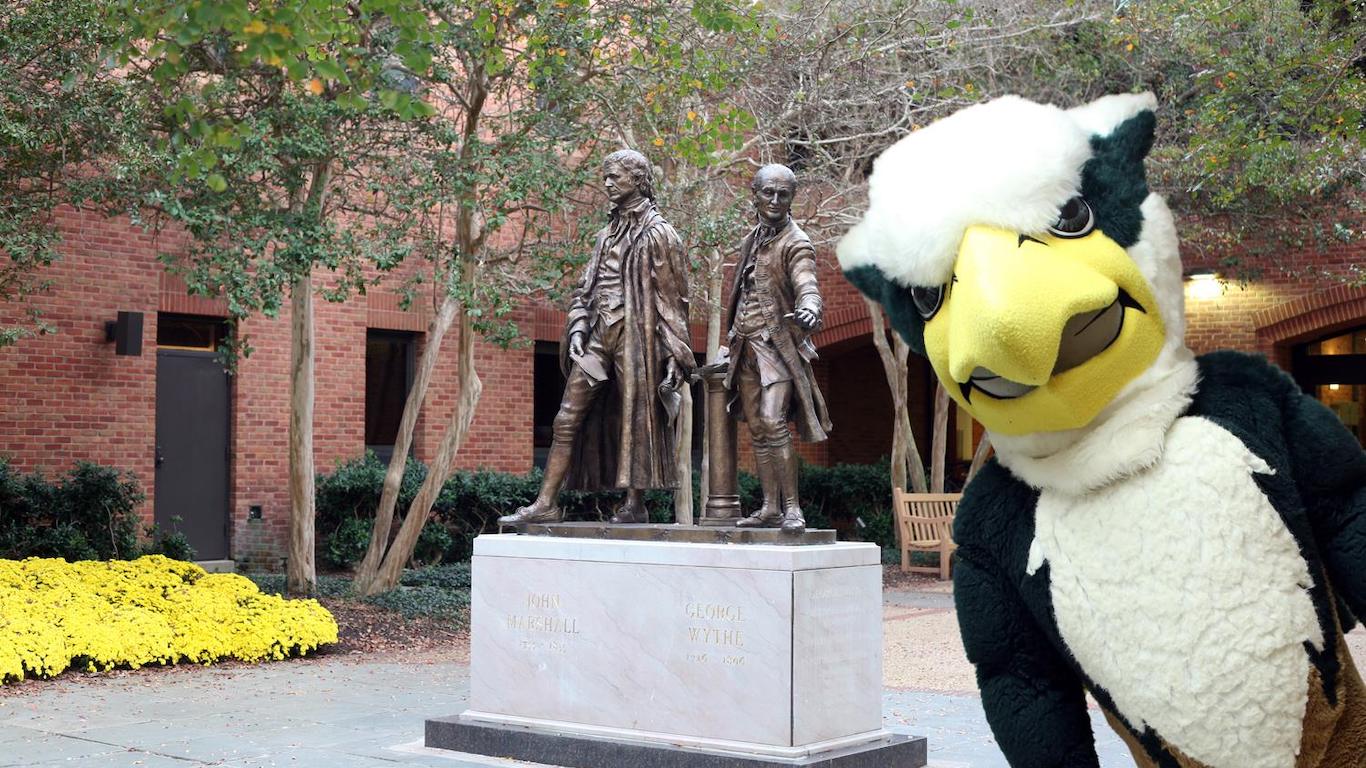
34. William & Mary Law School
> Acceptance rate: 30.4%
> Total 2019 applications: 3,291
> Median undergraduate GPA, first year class: 3.76
> Median LSAT score, first year class: 163
> Bar passage rate: 90.9%
William & Mary Law School is tied to the second oldest higher education institution in the country, William and Mary, which was chartered in 1693 by King William III and Queen Mary II of England. Located in historic Williamsburg, Virginia, the law school, too, is one of the oldest in the country, founded in 1779 and accredited in 1932.
Those accepted to the school are generally high academic achievers. The median undergraduate GPA among first years in 2019 was 3.76.
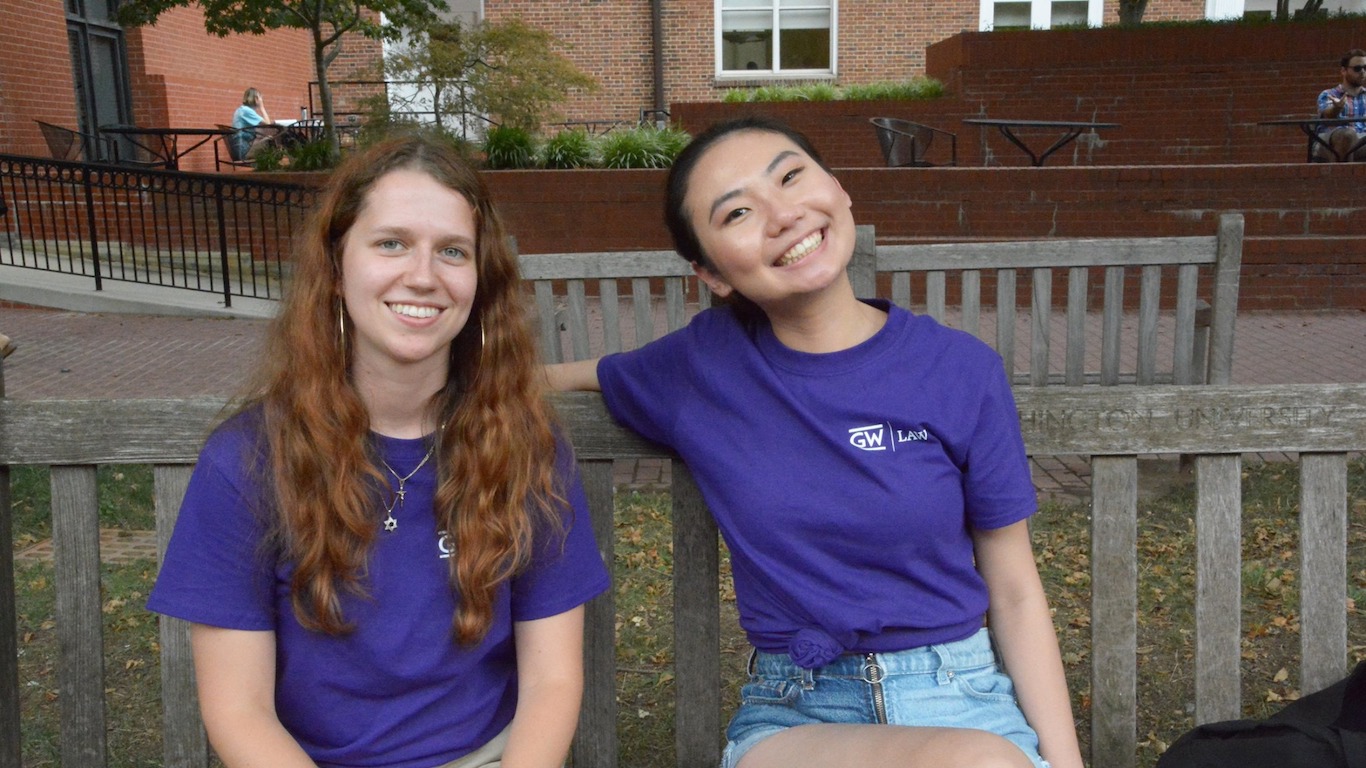
33. George Washington University Law School
> Acceptance rate: 31.0%
> Total 2019 applications: 8,019
> Median undergraduate GPA, first year class: 3.73
> Median LSAT score, first year class: 166
> Bar passage rate: 88.0%
Students enrolled at George Washington University Law School had especially high LSAT scores relative to those at most U.S. law schools. The median LSAT score among first years in 2019 was 166 out of 180, in the top 20 of all ABA accredited schools. Additionally, the median undergraduate GPA among first years in 2019 was 3.73, higher than in all but 30 other ABA accredited schools.
32. William S. Boyd School of Law at the University of Nevada, Las Vegas
> Acceptance rate: 27.2%
> Total 2019 applications: 947
> Median undergraduate GPA, first year class: 3.69
> Median LSAT score, first year class: 159
> Bar passage rate: 76.4%
William S. Boyd School of Law at the University of Nevada, Las Vegas — chartered in 2000 — is the first and only public law school in the state. Based on the school’s acceptance rate and first-year student undergraduate academic performance, it is one of the hardest to get into in the country. However, unlike most schools on this list, many graduates of the William S. Boyd School of Law are not adequately prepared to take the bar exam. Only about three-quarters of first time exam takers in 2019 passed, a lower passage rate than the 79.6% rate across all ABA accredited schools. It should be noted, however, that Nevada has one of the most difficult bar exams in the country.
[in-text-ad-2]
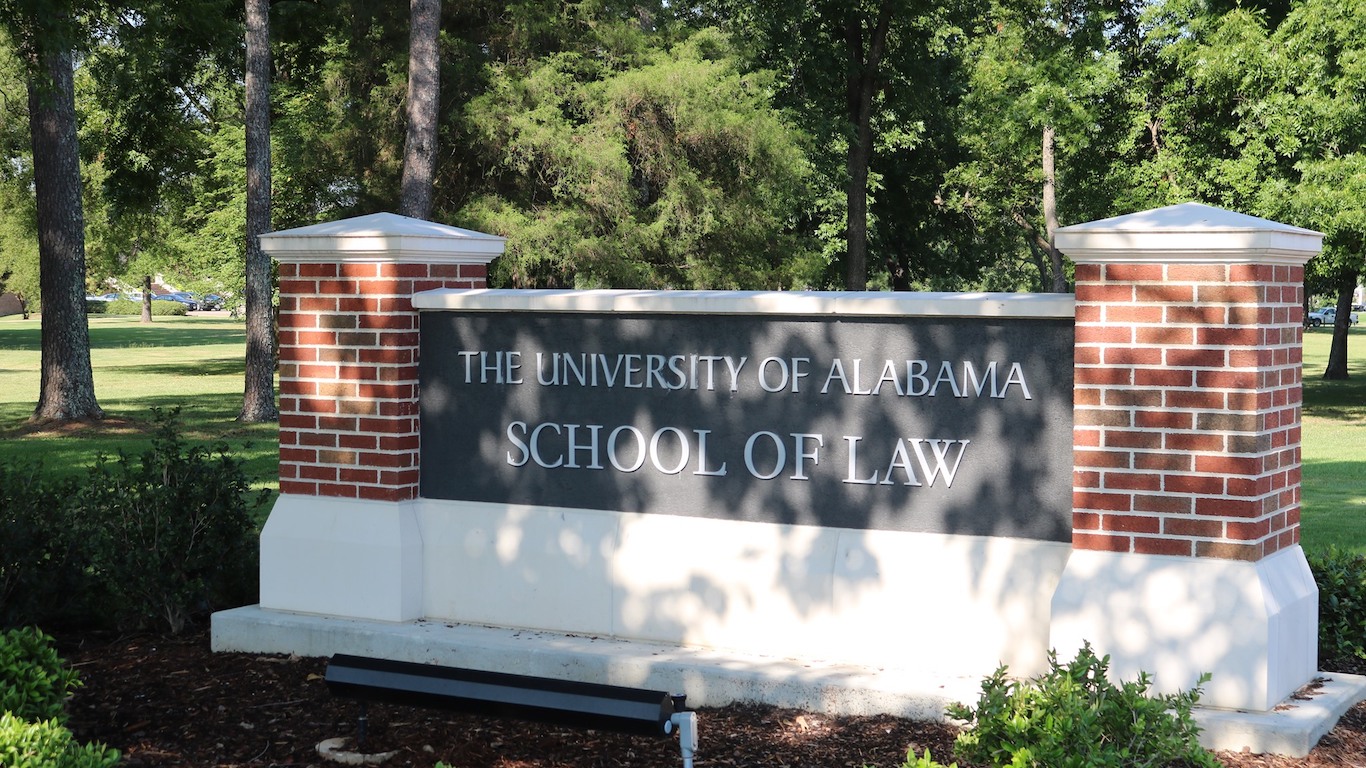
31. University of Alabama School of Law
> Acceptance rate: 32.8%
> Total 2019 applications: 1,446
> Median undergraduate GPA, first year class: 3.91
> Median LSAT score, first year class: 164
> Bar passage rate: 93.7%
The University of Alabama School of Law in Tuscaloosa accepted fewer than one-third of all applicants in the 2019 academic year. Those accepted to the school are generally high academic achievers. The median undergraduate GPA among first years in 2019 was a near perfect 3.91. The only school on this list with a higher first-year undergraduate GPA is Yale.
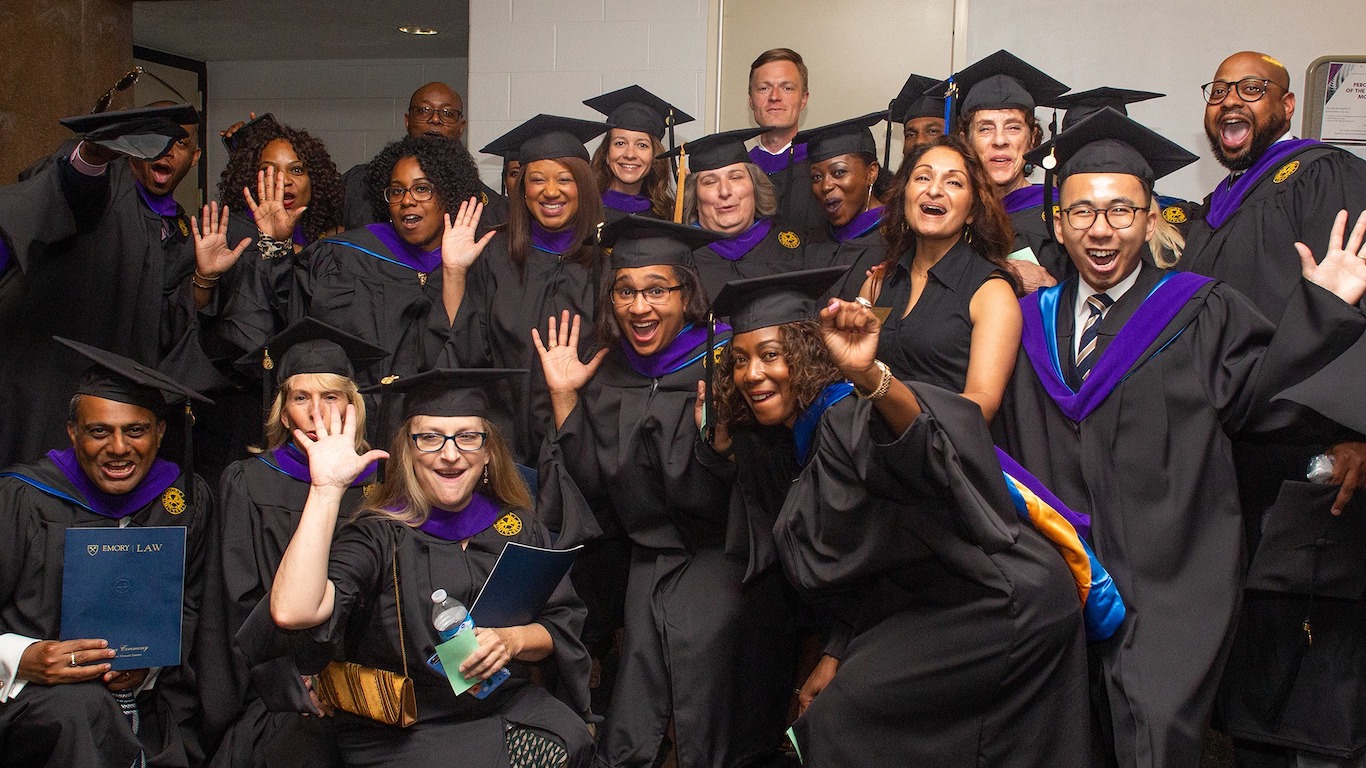
30. Emory University School of Law
> Acceptance rate: 31.0%
> Total 2019 applications: 4,316
> Median undergraduate GPA, first year class: 3.80
> Median LSAT score, first year class: 165
> Bar passage rate: 82.8%
Emory University School of Law, located in Atlanta, Georgia, has an acceptance rate of just 31.0%, lower than all but 37 other law schools nationwide. The median undergraduate GPA among first years at the school in 2019 was 3.8, higher than the median undergraduate GPA in all but 14 other law schools nationwide. Emory was approved by the ABA in 1923 and has over 12,000 alumni.
[in-text-ad]
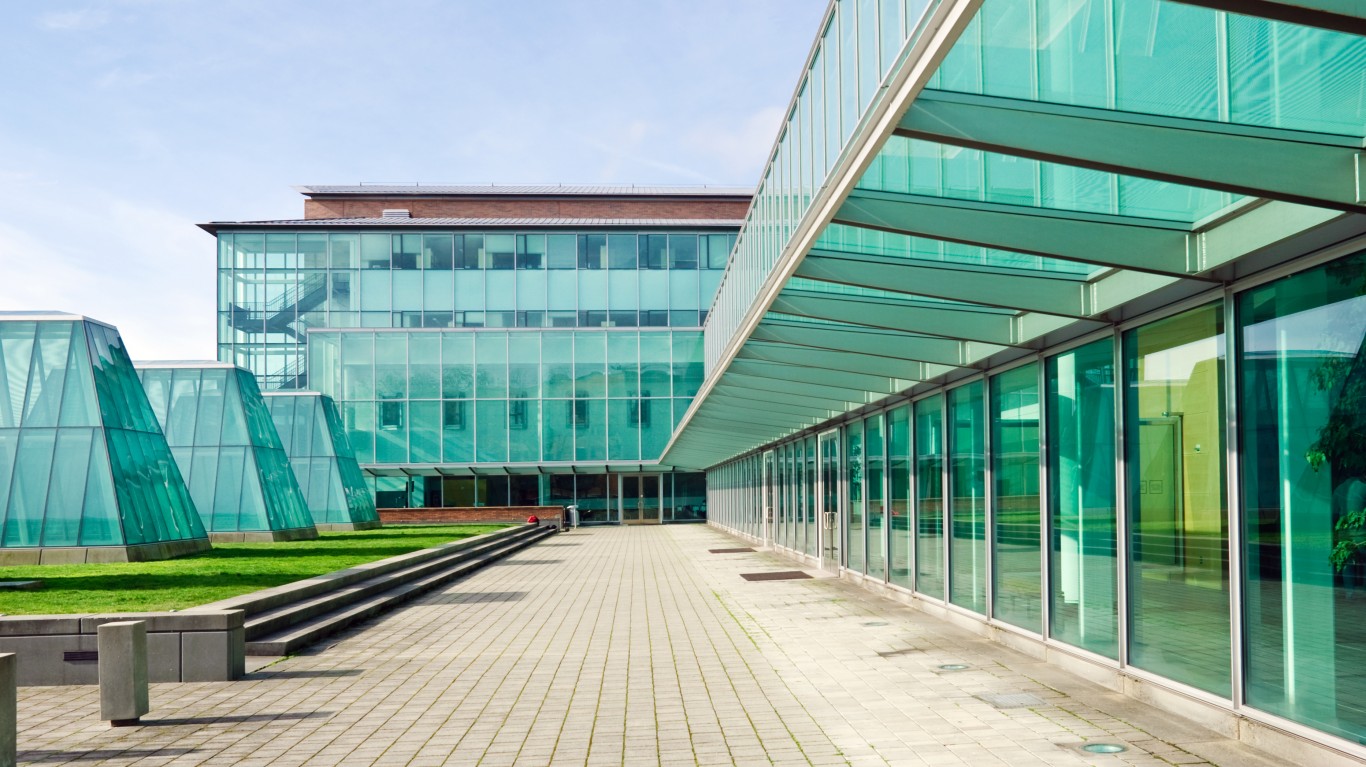
29. University of Washington School of Law
> Acceptance rate: 27.8%
> Total 2019 applications: 2,555
> Median undergraduate GPA, first year class: 3.68
> Median LSAT score, first year class: 162
> Bar passage rate: 84.4%
The University of Washington School of Law in Seattle has one of the lowest acceptance rates of any ABA accredited school. Just 27.8% of the 2,555 applicants were offered admission in 2019, one of the 30 lowest acceptance rates of any ABA accredited school. Originally opened as the Department of Law at the University of Washington in 1899, the school was officially recognized by the ABA in 1924, making it one of the oldest law schools in the United States.
28. Fordham University School of Law
> Acceptance rate: 27.2%
> Total 2019 applications: 5,285
> Median undergraduate GPA, first year class: 3.64
> Median LSAT score, first year class: 164
> Bar passage rate: 89.4%
Fordham University School of Law, located in Manhattan, has an especially low acceptance rate. Only 27.2% of applicants were accepted in 2019, one of the 30 lowest acceptance rates of any ABA accredited school. Along with the New York University School of Law and Columbia Law School, Fordham is one of several highly selective schools located in New York City.
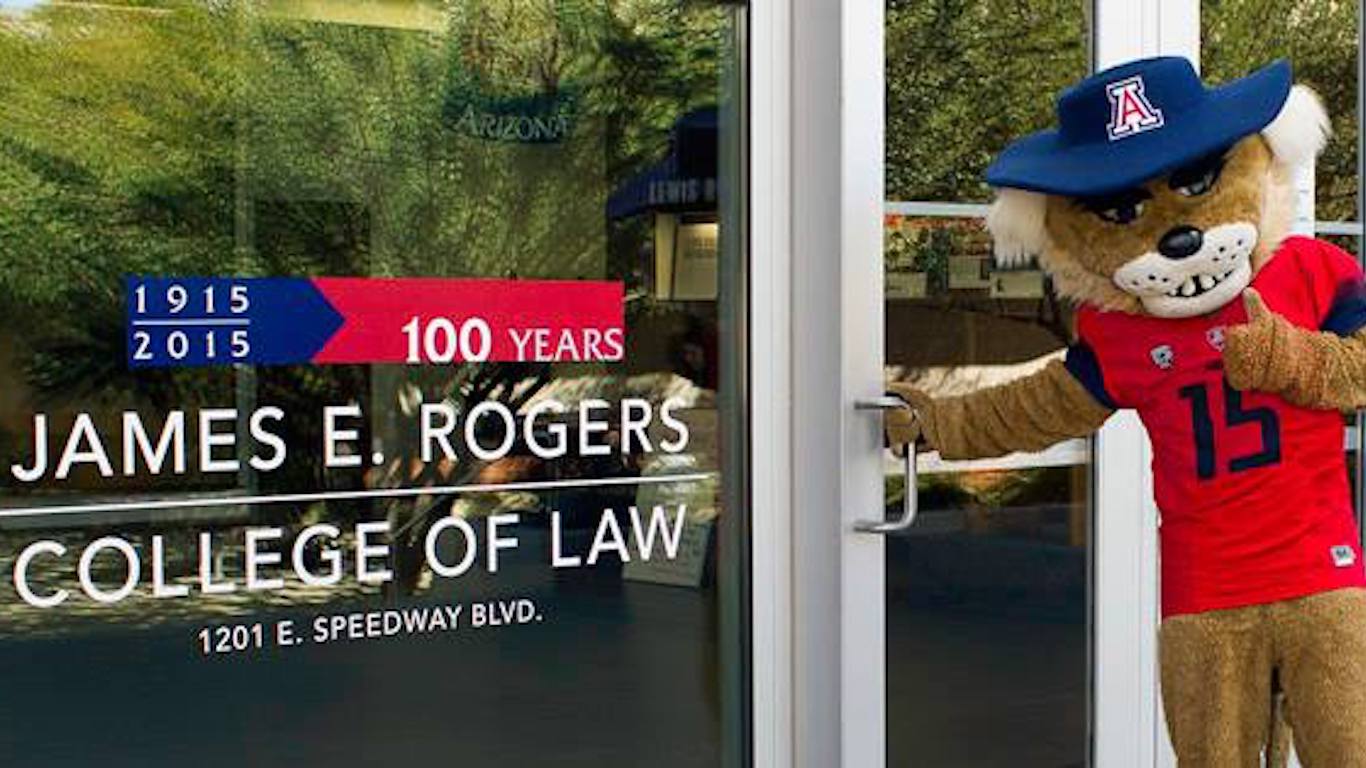
27. James E. Rogers College of Law at the University of Arizona
> Acceptance rate: 26.3%
> Total 2019 applications: 1,495
> Median undergraduate GPA, first year class: 3.65
> Median LSAT score, first year class: 162
> Bar passage rate: 66.7%
The James E. Rogers College of Law at the University of Arizona accepted just 26.3% of applicants in 2019, a smaller share than all but 25 other law schools nationwide. Though the school is selective and first year students have generally high undergraduate GPAs and LSAT scores, many graduates of James E. Rogers College of Law are not adequately prepared for the bar exam. Only about two-thirds of graduates taking the bar exam for the first time in 2019 passed, compared with about four out of five of all first-time bar exam takers the same year. It should be noted that each state’s bar exam is different, and Arizona has one of the lowest passage rates of any state.
[in-text-ad-2]
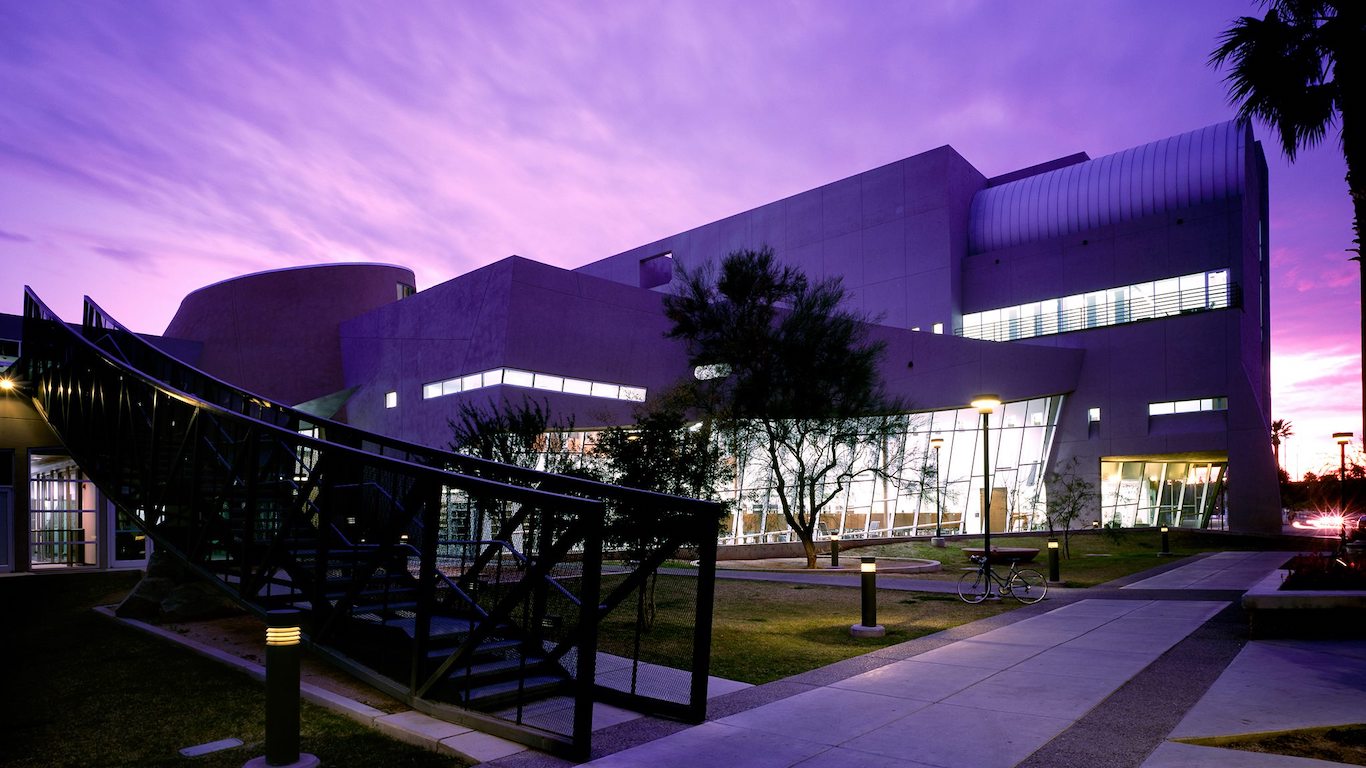
26. Sandra Day O’Connor College of Law at Arizona State University
> Acceptance rate: 29.4%
> Total 2019 applications: 3,710
> Median undergraduate GPA, first year class: 3.81
> Median LSAT score, first year class: 164
> Bar passage rate: 86.7%
The Sandra Day O’Connor College of Law at Arizona State University accepted fewer than one-third of all applicants for the 2019 academic year. One of the most selective law schools in the country, Sandra Day O’Connor College of Law is named for the Arizona state senator and first female justice appointed to the U.S. Supreme Court. O’Connor graduated from Stanford Law, another school on this list, in 1952 — 17 years before the school bearing her name was recognized by the ABA.
25. Notre Dame Law School
> Acceptance rate: 24.0%
> Total 2019 applications: 2,753
> Median undergraduate GPA, first year class: 3.74
> Median LSAT score, first year class: 165
> Bar passage rate: 90.2%
Founded in 1869 and accredited by the ABA in 1925, Notre Dame Law School is the oldest Roman Catholic law school in the United States. It is also one of the most selective schools in the country, as one of only 25 law schools to accept fewer than one-quarter of all applicants in 2019.
The school appears to do a better job than most at preparing students for for the bar exam, as over 90% of graduates and first time takers of the bar exam in 2019 passed, well above the 79.6% passage rate among all first time bar exam takers that year.
[in-text-ad]
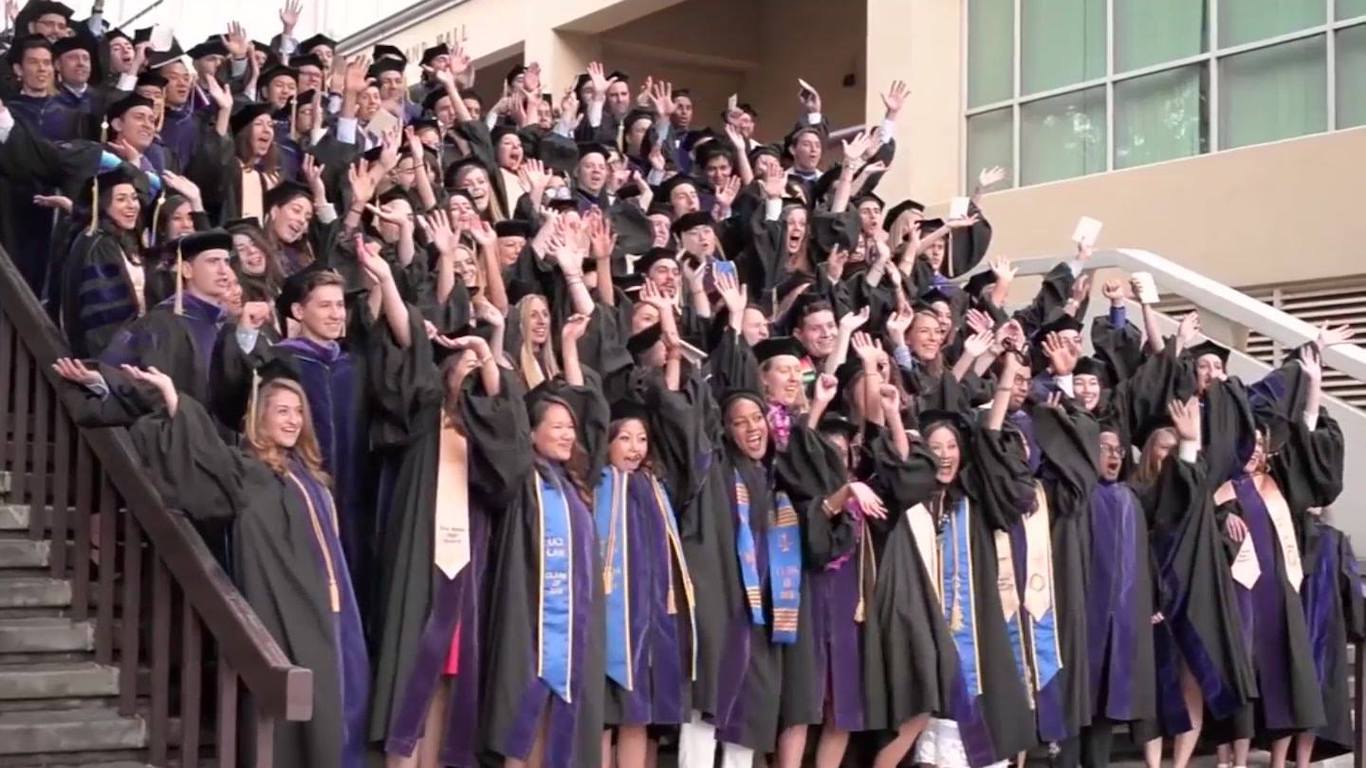
24. University of California-Irvine School of Law
> Acceptance rate: 20.8%
> Total 2019 applications: 3,147
> Median undergraduate GPA, first year class: 3.59
> Median LSAT score, first year class: 165
> Bar passage rate: 81.5%
The University of California-Irvine School of Law is one of several public California law schools to rank on this list. For the 2019 academic year, the school accepted only about one-fifth of applicants — a lower acceptance rate than all but 15 other ABA accredited schools.
While its admissions standards are high, graduates of the school are not necessarily in a better position to begin a career practicing law than those of many other schools. Just 81.5% of graduates and first-time bar exam takers passed in 2019, only slightly higher than the 79.6% first-time bar passage rate across all ABA accredited schools. It is important to note, however, that bar exam difficulty can vary by state, and California’s is notoriously difficult, and the state regularly has the lowest passage rate in the country.
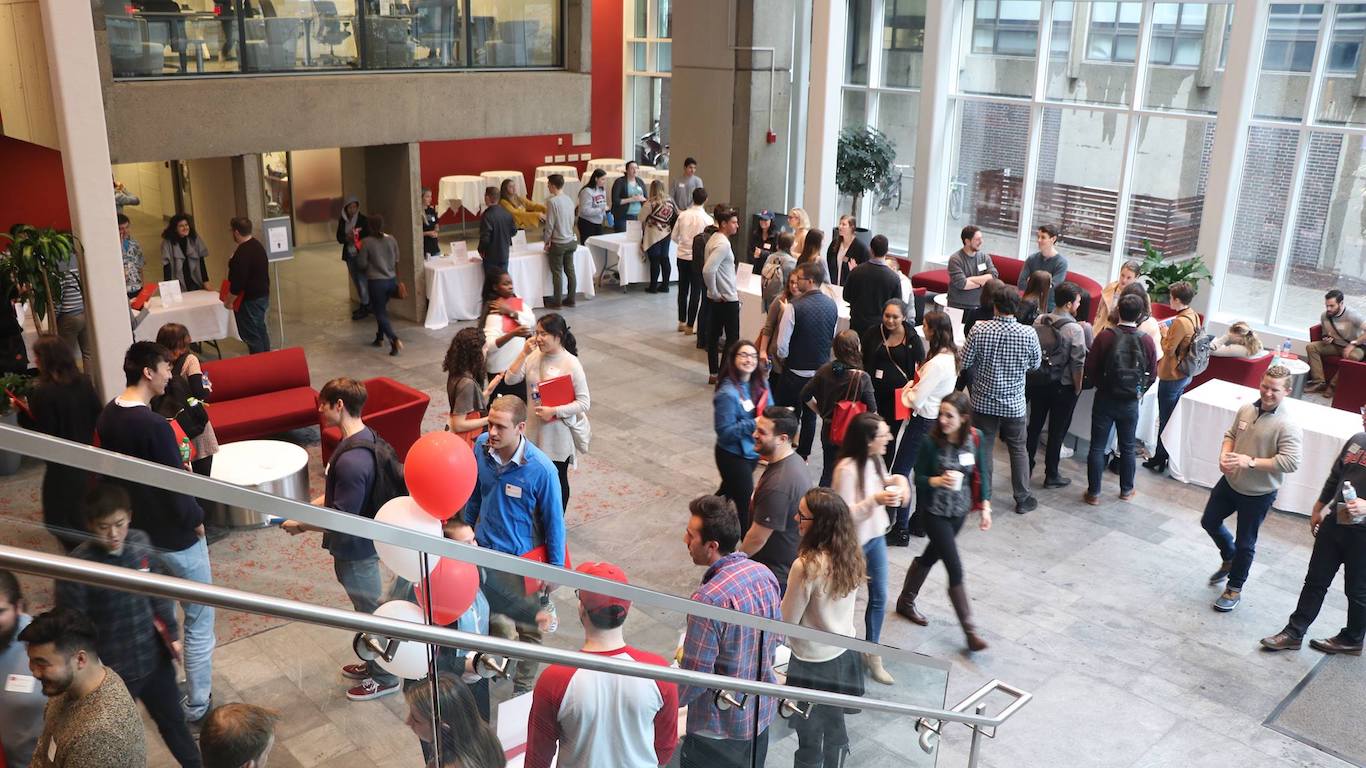
23. Boston University School of Law
> Acceptance rate: 23.1%
> Total 2019 applications: 5,812
> Median undergraduate GPA, first year class: 3.78
> Median LSAT score, first year class: 166
> Bar passage rate: 91.6%
Boston University School of Law ranks as the 23rd hardest law school to get into. It also has the 23rd lowest acceptance rate among accredited law schools, at 23.1% and the 23rd highest median undergraduate GPA among first year students, at 3.78. It is also one of just 38 law schools where at least 90% of first-time bar exam takers passed the test in 2019.
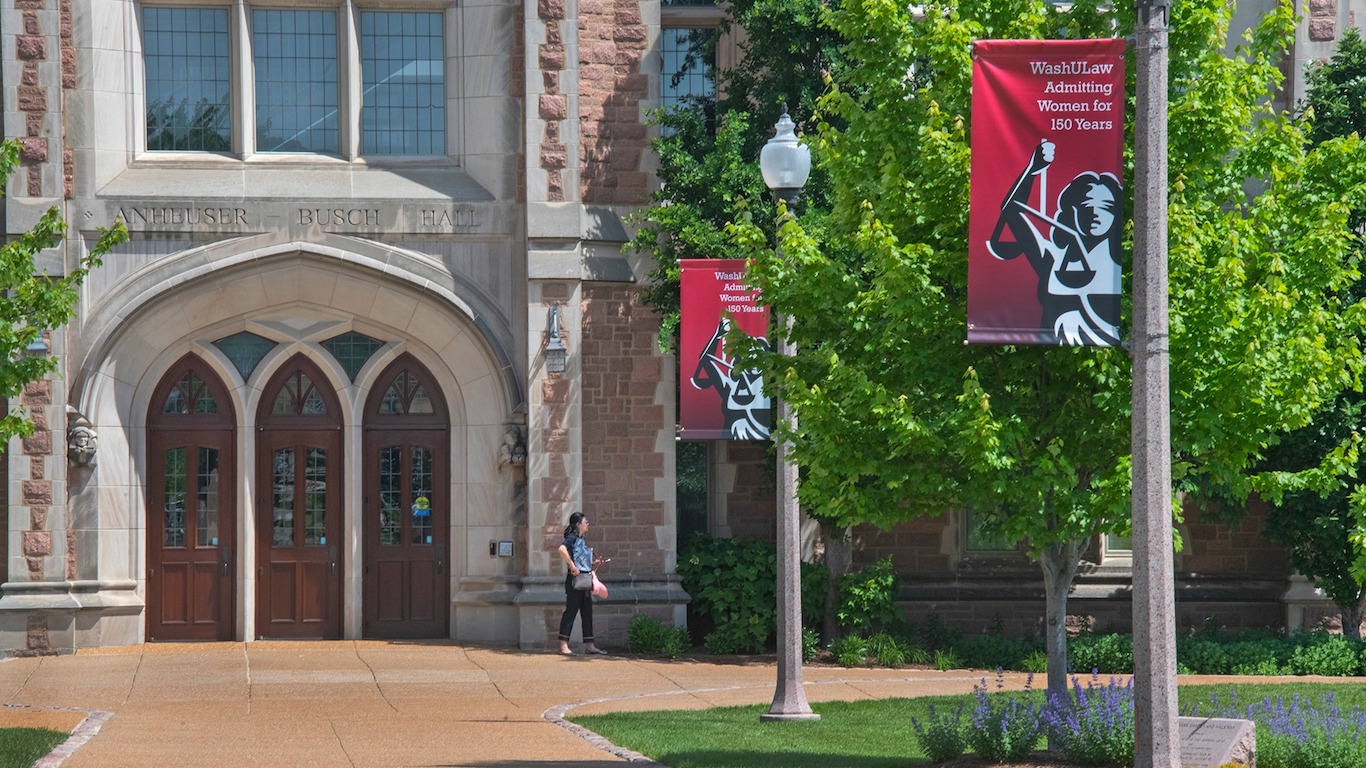
22. Washington University in St. Louis School of Law
> Acceptance rate: 24.8%
> Total 2019 applications: 4,129
> Median undergraduate GPA, first year class: 3.83
> Median LSAT score, first year class: 169
> Bar passage rate: 89.1%
Washington University in St. Louis School of Law ranks on this list for several reasons. It is one of only 25 law schools nationwide to accept fewer than 25% of applicants in the 2019 school year. Those who were accepted had generally strong academic records. The typical first year in 2019 had an undergraduate GPA of 3.83 and LSAT score of 169 out of 180.
Washington University in St. Louis School of Law is not just one of the hardest to get into but also one of the oldest. The school was founded in 1867 and approved by the ABA in 1923.
[in-text-ad-2]
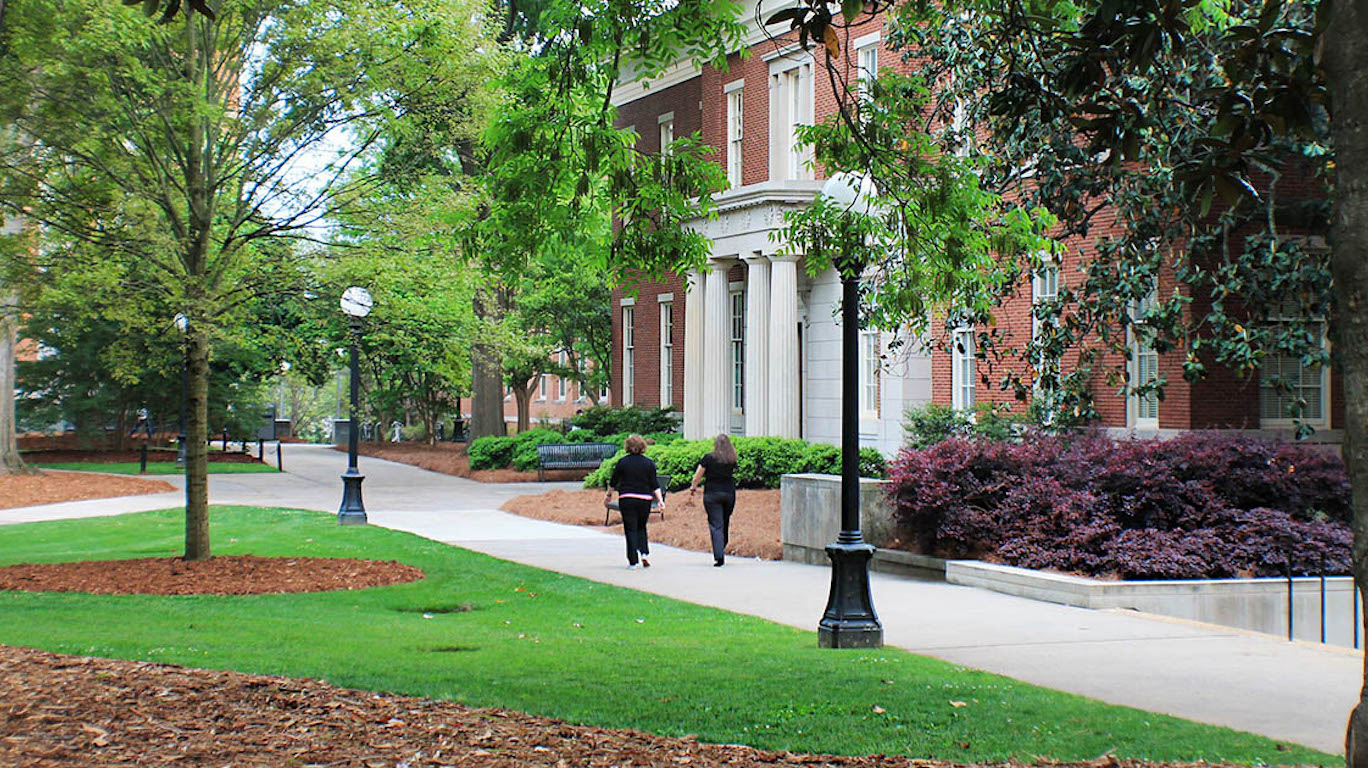
21. University of Georgia School of Law
> Acceptance rate: 20.8%
> Total 2019 applications: 2,268
> Median undergraduate GPA, first year class: 3.73
> Median LSAT score, first year class: 164
> Bar passage rate: 91.8%
University of Georgia School of Law first-year students in 2019 had among the strongest academic performance of those going to any law school in the country. Their median undergraduate GPA of 3.73 and median LSAT score of 164 were both higher than the vast majority of accredited law schools. The University of Georgia School of Law accepted just 20.8% of applicants for fall 2019, a lower acceptance rate than all but 15 other law schools.

20. Antonin Scalia Law School at George Mason University
> Acceptance rate: 20.9%
> Total 2019 applications: 2,964
> Median undergraduate GPA, first year class: 3.75
> Median LSAT score, first year class: 164
> Bar passage rate: 87.9%
The Antonin Scalia Law School at George Mason University in Arlington, Virginia, accepted only about one-fifth of the nearly 3,000 applicants for the 2019 academic year. Students admitted to the school generally have strong academic records. The typical first year has an undergraduate GPA of 3.75 and an LSAT score of 164 out of 180.
The school is named for the U.S. Supreme Court Justice Antonin Scalia. Scalia, who passed away in 2016, attended Harvard Law School, which also ranks on this list.
[in-text-ad]
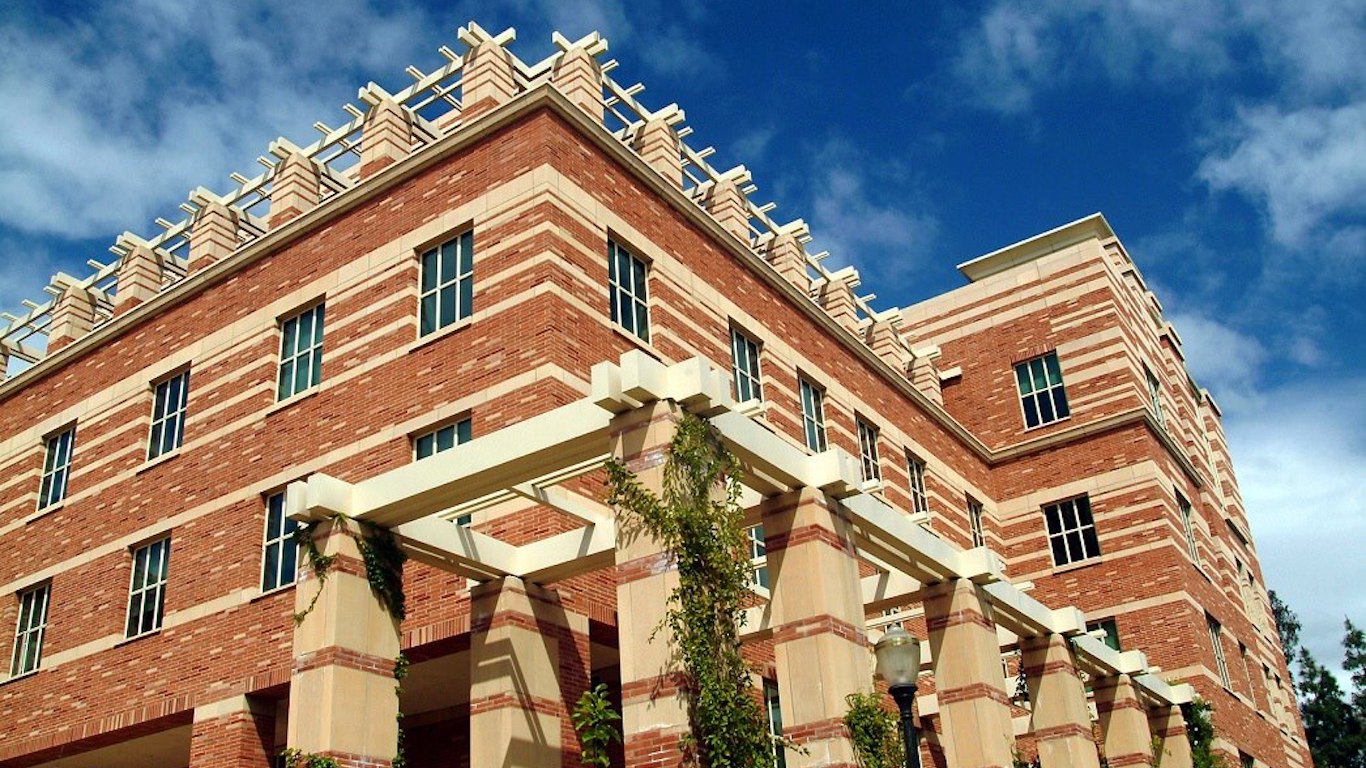
19. University of California-Los Angeles School of Law
> Acceptance rate: 22.4%
> Total 2019 applications: 6,175
> Median undergraduate GPA, first year class: 3.79
> Median LSAT score, first year class: 168
> Bar passage rate: 89.5%
The typical first year student at the UCLA School of Law has an undergraduate GPA of 3.79 and an LSAT score of 168, higher than the comparable figures in the vast majority of ABA approved institutions. Additionally, though California is widely recognized as having one of the most difficult bar exams — evidenced by a lowest-in-the-nation passage rate — 89.5% of graduates taking the bar for the first time in 2019 passed, above the 79.6% passage rate among first-time exam takers of all schools.
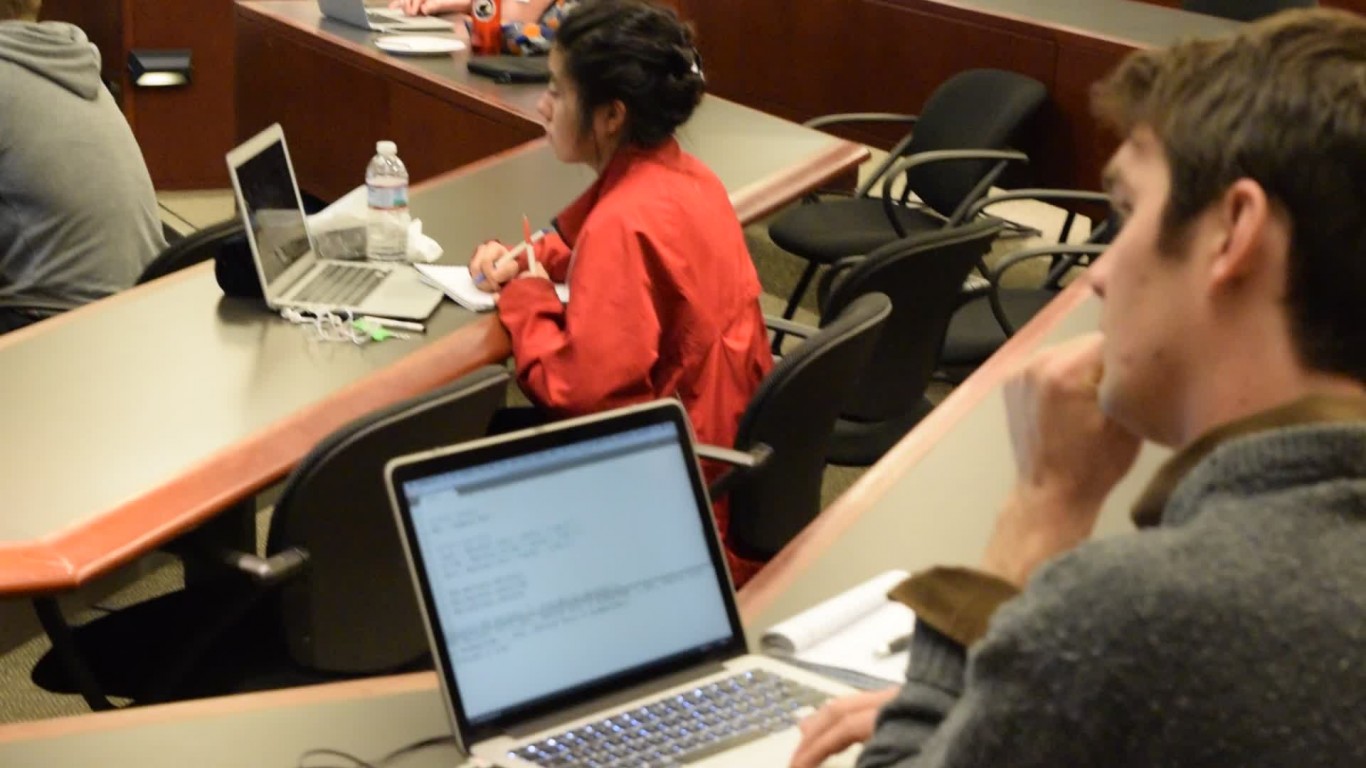
18. Vanderbilt University Law School
> Acceptance rate: 21.9%
> Total 2019 applications: 5,294
> Median undergraduate GPA, first year class: 3.80
> Median LSAT score, first year class: 167
> Bar passage rate: 94.2%
Vanderbilt University Law School, located in Nashville, Tennessee, is one of the most exclusive law schools in the South and the entire country. Its class of fall 2019 enrollees had a median undergraduate GPA of 3.80 and a median LSAT score of 167 out of 180 — both top 20 in the nation. Of the 205 first time bar exam takers from the school, 193 passed the test in 2019, a higher first-time passage rate than all but 14 other accredited law schools in the nation.
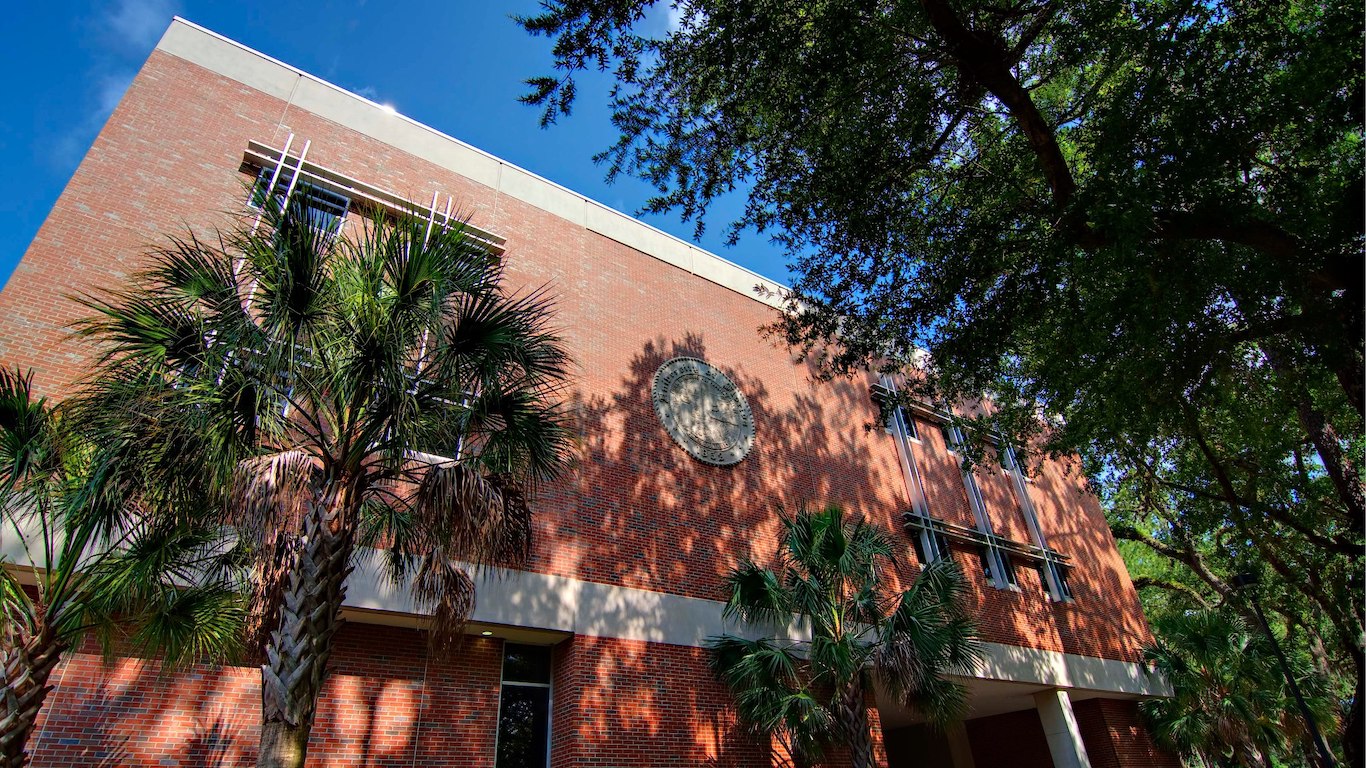
17. University of Florida Levin College of Law
> Acceptance rate: 20.7%
> Total 2019 applications: 2,208
> Median undergraduate GPA, first year class: 3.80
> Median LSAT score, first year class: 164
> Bar passage rate: 87.1%
University of Florida Levin College of Law admitted about one out of every five applicants in the fall of 2019, making it one of the most selective law schools in America. The Levin College of Law had 326 first-time bar exam takers in 2019, one of the highest totals among all schools. Its 87.1% passage rate was well above the 79.6% rate among all first-time takers that year.
[in-text-ad-2]
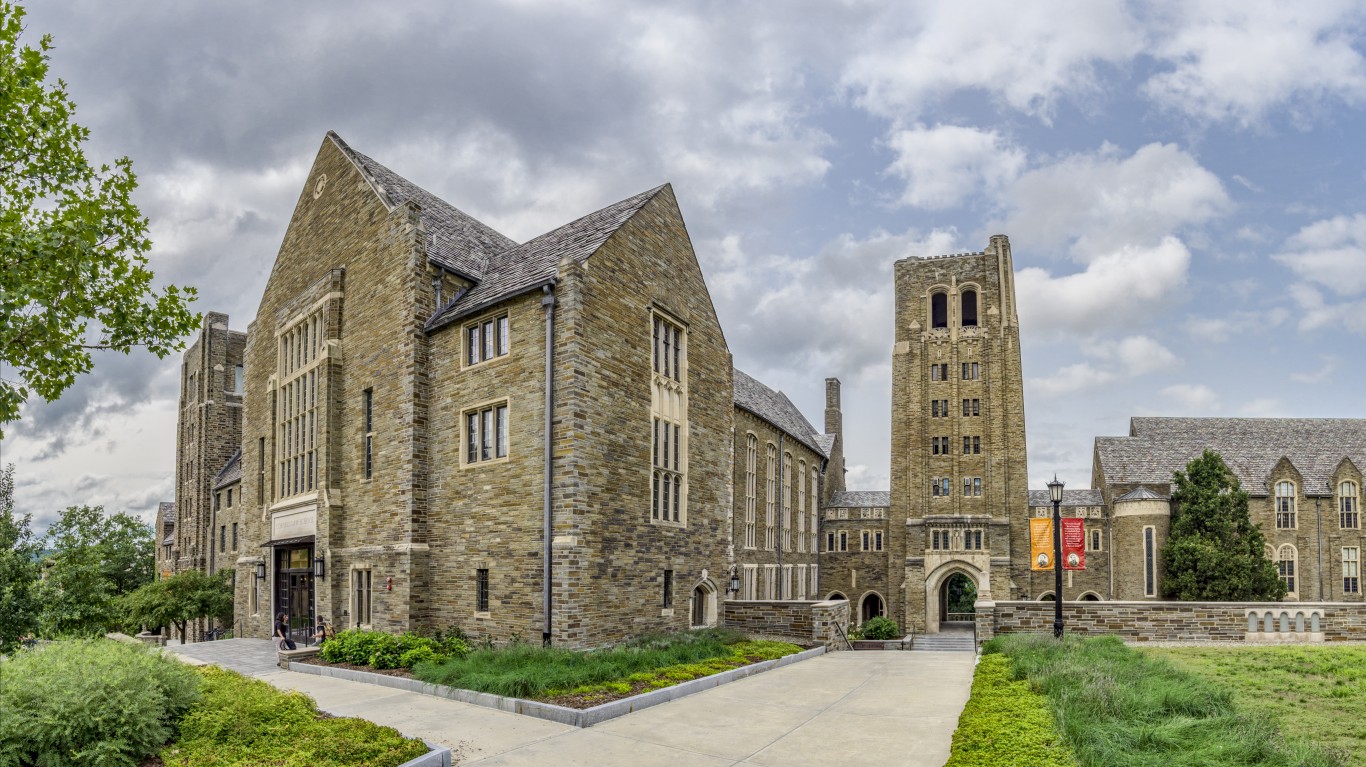
16. Cornell Law School
> Acceptance rate: 21.3%
> Total 2019 applications: 4,098
> Median undergraduate GPA, first year class: 3.81
> Median LSAT score, first year class: 168
> Bar passage rate: 93.8%
Cornell Law School is one of several Ivy League universities’ law schools to rank among the hardest to get into in the nation. The school’s 2019 first year class median undergraduate GPA of 3.81 was higher than all but 10 other law schools. The class’s median LSAT score of 168 was also among the top 15.
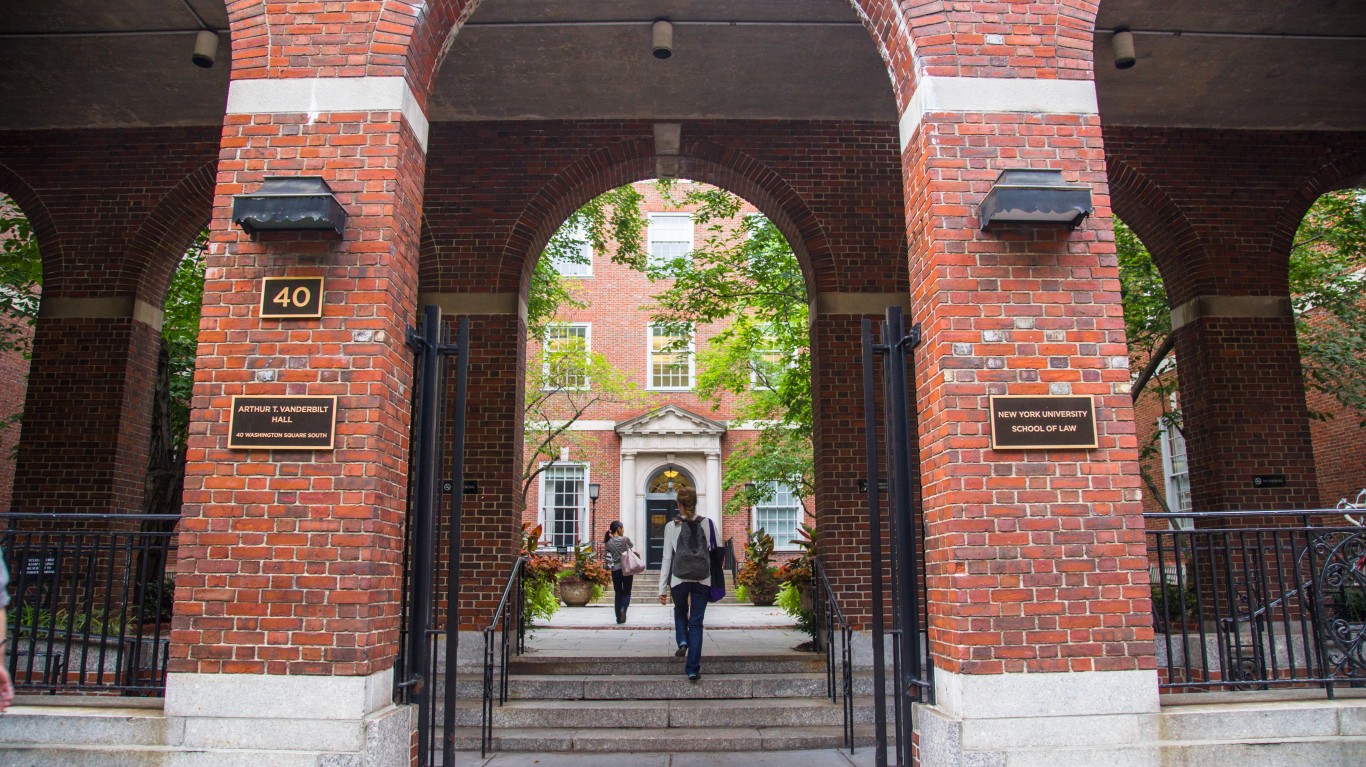
15. New York University School of Law
> Acceptance rate: 21.6%
> Total 2019 applications: 7,959
> Median undergraduate GPA, first year class: 3.80
> Median LSAT score, first year class: 170
> Bar passage rate: 96.0%
New York University School of Law’s first year class in 2019 had a median LSAT score of 170 out of a possible 180 — tied for fifth among all accredited American law schools. Its first-time bar passage rate of 96% was also among the best in the nation, ranked ninth. The Manhattan-based law school is the second largest in the nation, with a total enrollment of over 2,000 students.
[in-text-ad]
14. Georgetown University Law Center
> Acceptance rate: 19.5%
> Total 2019 applications: 10,366
> Median undergraduate GPA, first year class: 3.78
> Median LSAT score, first year class: 168
> Bar passage rate: 92.7%
Georgetown University Law Center had by far the most applicants of any accredited U.S. law school in 2019, at 10,366, surpassing the next closest school by over 2,000. Yet just 19.5% of applicants were admitted, a lower share than all but a dozen other schools. First-year Georgetown law students in 2019 had a median undergraduate GPA of 3.78, the 23rd best in the nation, and a median LSAT score of 168 out of 180 — the 13th best. Those from Georgetown who took the bar for the first time in 2019 had a 92.7% passage rate, the 20th best in the nation.
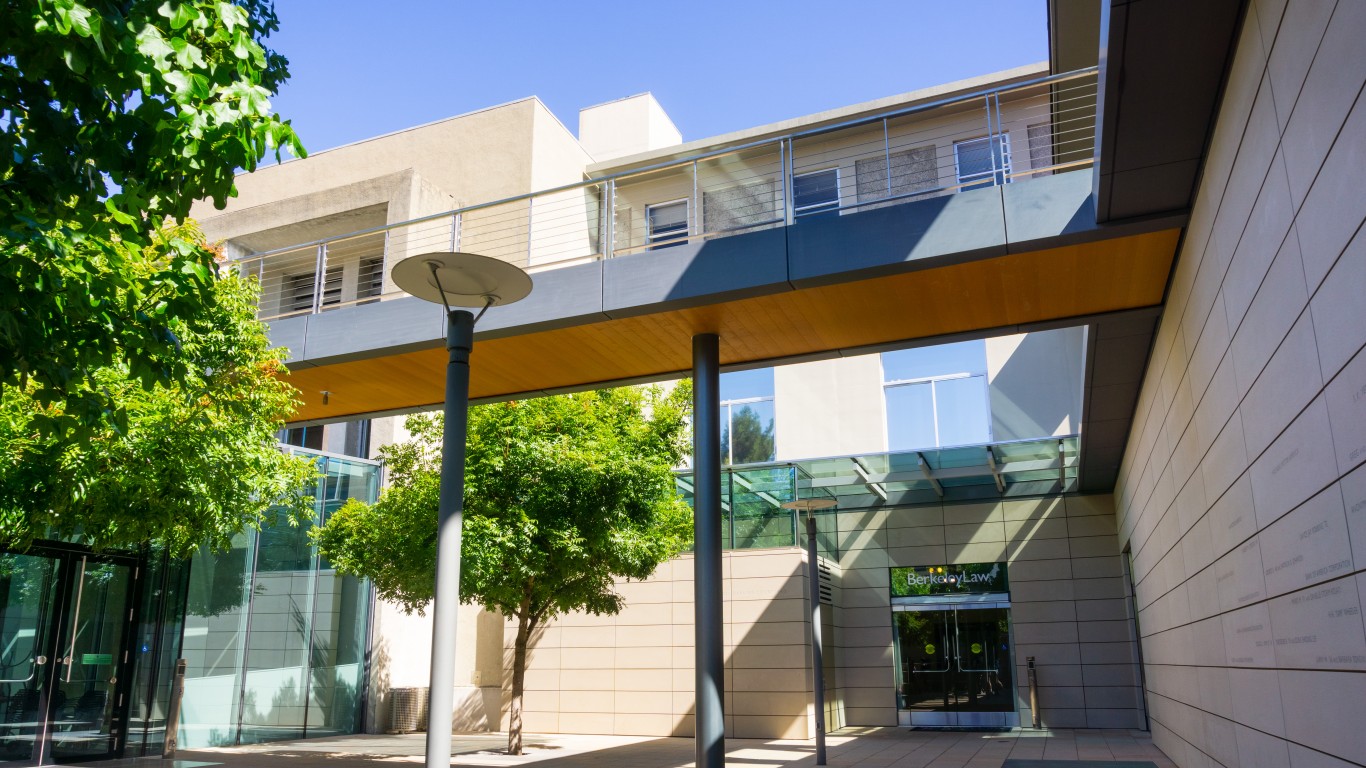
13. University of California-Berkeley School of Law
> Acceptance rate: 19.7%
> Total 2019 applications: 5,843
> Median undergraduate GPA, first year class: 3.81
> Median LSAT score, first year class: 168
> Bar passage rate: 90.4%
University of California-Berkeley School of Law is one of just 14 law schools to admit fewer than 20% of applicants. It is also just one of 38 law schools with a bar exam passage rate of more than 90% in 2019 for first-time takers. Its fall 2019 first-year class ranks among the top 15 in terms of median undergraduate GPA, at 3.81, and median LSAT score, at 168.
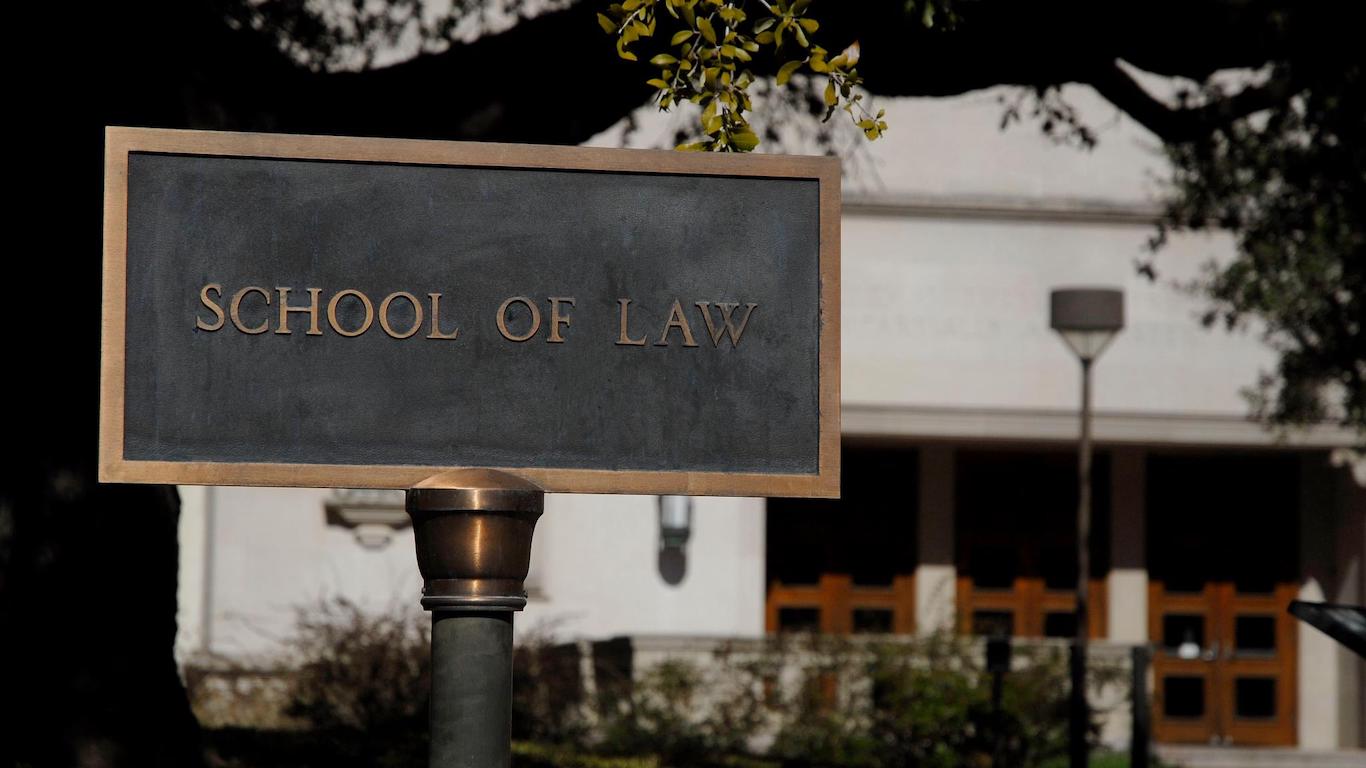
12. University of Texas at Austin School of Law
> Acceptance rate: 17.5%
> Total 2019 applications: 5,803
> Median undergraduate GPA, first year class: 3.72
> Median LSAT score, first year class: 168
> Bar passage rate: 93.3%
At 17.5%, University of Texas at Austin School of Law’s acceptance rate is the eighth lowest among ABA accredited schools. The school also boasted one of the 20 best bar passage rates among first time takers in 2019, at 93.3%. This is well above the overall 79.6% rate for all first time bar takers.
[in-text-ad-2]
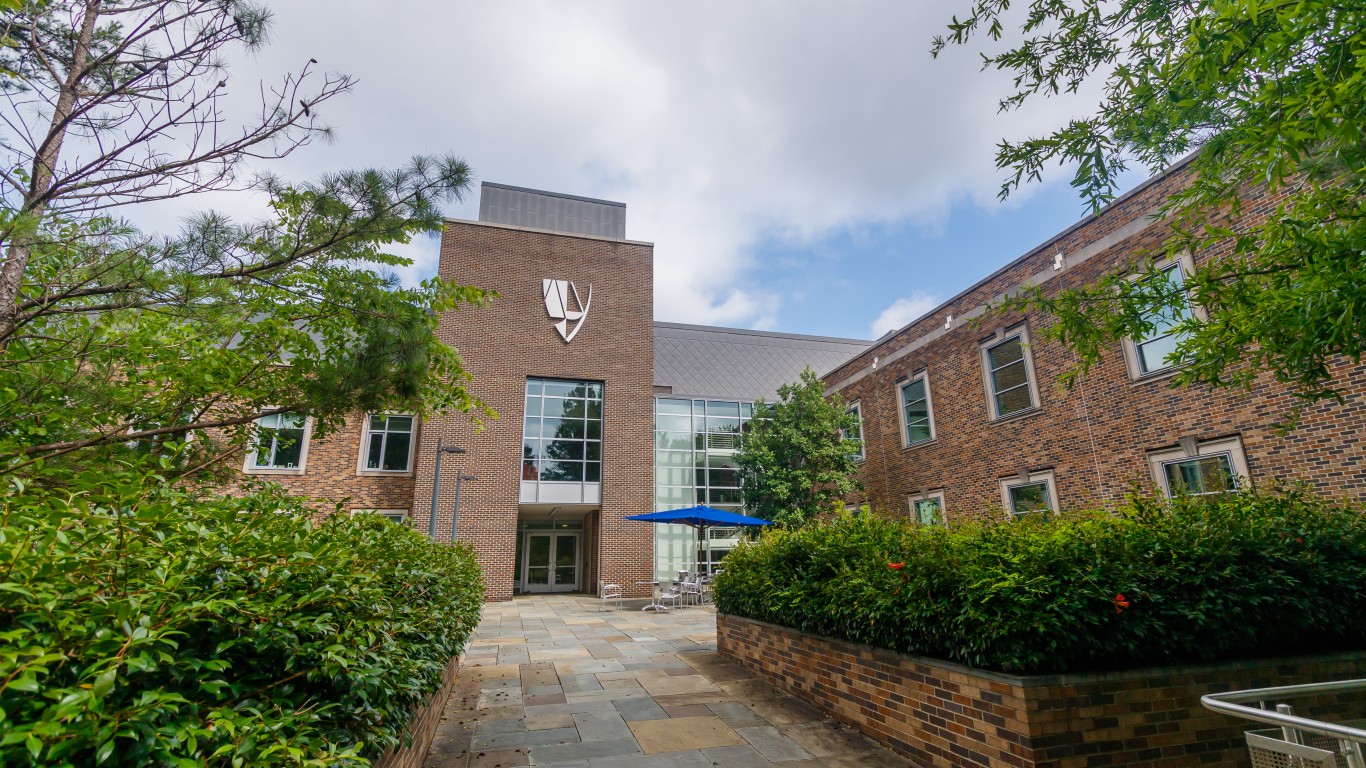
11. Duke University School of Law
> Acceptance rate: 18.9%
> Total 2019 applications: 5,125
> Median undergraduate GPA, first year class: 3.78
> Median LSAT score, first year class: 169
> Bar passage rate: 97.7%
Duke University School of Law is one of the most selective in the nation, admitting fewer than 19% of applicants. Only 11 schools have a lower acceptance rate. Duke law school graduates tend to do well after graduating. In 2019, 97.7% of first-time bar exam takers from the school passed the test — the fourth-best passage rate of any school. Also, the unemployment rate among Its 2018 graduates was just 0.9% the year after graduating, the ninth-lowest rate of any law school.
10. University of Southern California Gould School of Law
> Acceptance rate: 17.7%
> Total 2019 applications: 5,648
> Median undergraduate GPA, first year class: 3.80
> Median LSAT score, first year class: 166
> Bar passage rate: 87.7%
The University of Southern California Gould School of Law is the hardest law school to get into in the Western part of the country. It is highly selective, with just 17.7% of applicants admitted to the fall 2019 class. The first-year students in the fall of 2019 had a median undergraduate GPA of 3.80 and median LSAT score of 166 — both of which ranked among the top 20 for all law schools. Yet the school’s bar passage rate for first time takers in 2019 ranked 48th, at 87.7%.
[in-text-ad]
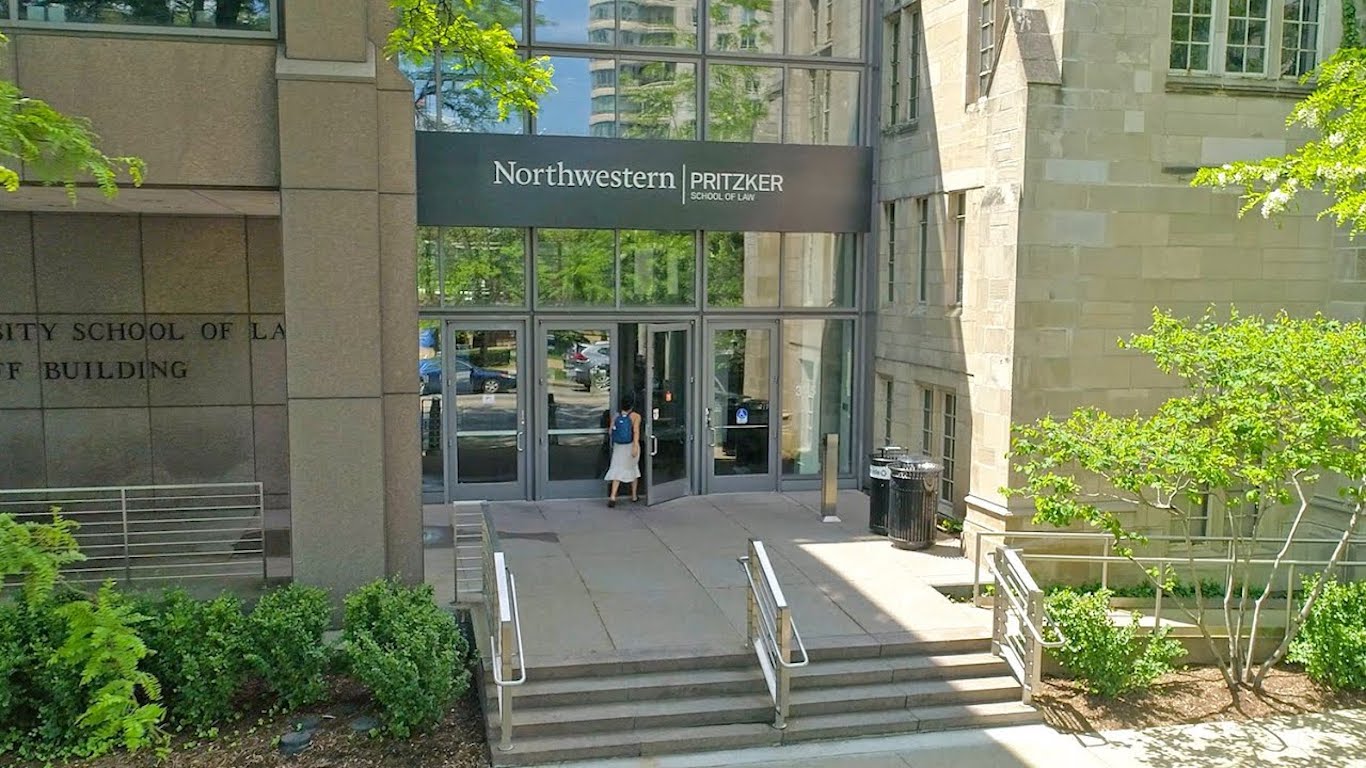
9. Northwestern University Pritzker School of Law
> Acceptance rate: 18.0%
> Total 2019 applications: 5,441
> Median undergraduate GPA, first year class: 3.85
> Median LSAT score, first year class: 169
> Bar passage rate: 92.0%
Northwestern University’s Pritzker School of Law, named for the family of current Illinois governor J.B. Pritzker, is one of the 10 hardest law schools to get into in America. It is one of two such schools located in Chicago. The school had one of the 10 lowest acceptance rates in 2019, at 18.0%. Its fall 2019 first-year class also ranked in the top 10 in median undergraduate GPA and LSAT score, at 3.85 and 169, respectively.
8. University of Chicago Law School
> Acceptance rate: 18.6%
> Total 2019 applications: 4,933
> Median undergraduate GPA, first year class: 3.90
> Median LSAT score, first year class: 170
> Bar passage rate: 96.5%
The University of Chicago Law School is one of three Midwestern law schools to rank among the 10 hardest to get into in America. The school received 4,933 applications for its fall 2019 first year class and admitted just 918 of those applicants, an 18.6% acceptance rate. The school’s first-year students that semester ranked in the top five in both median undergraduate GPA, at 3.90, and median LSAT score, at 170.
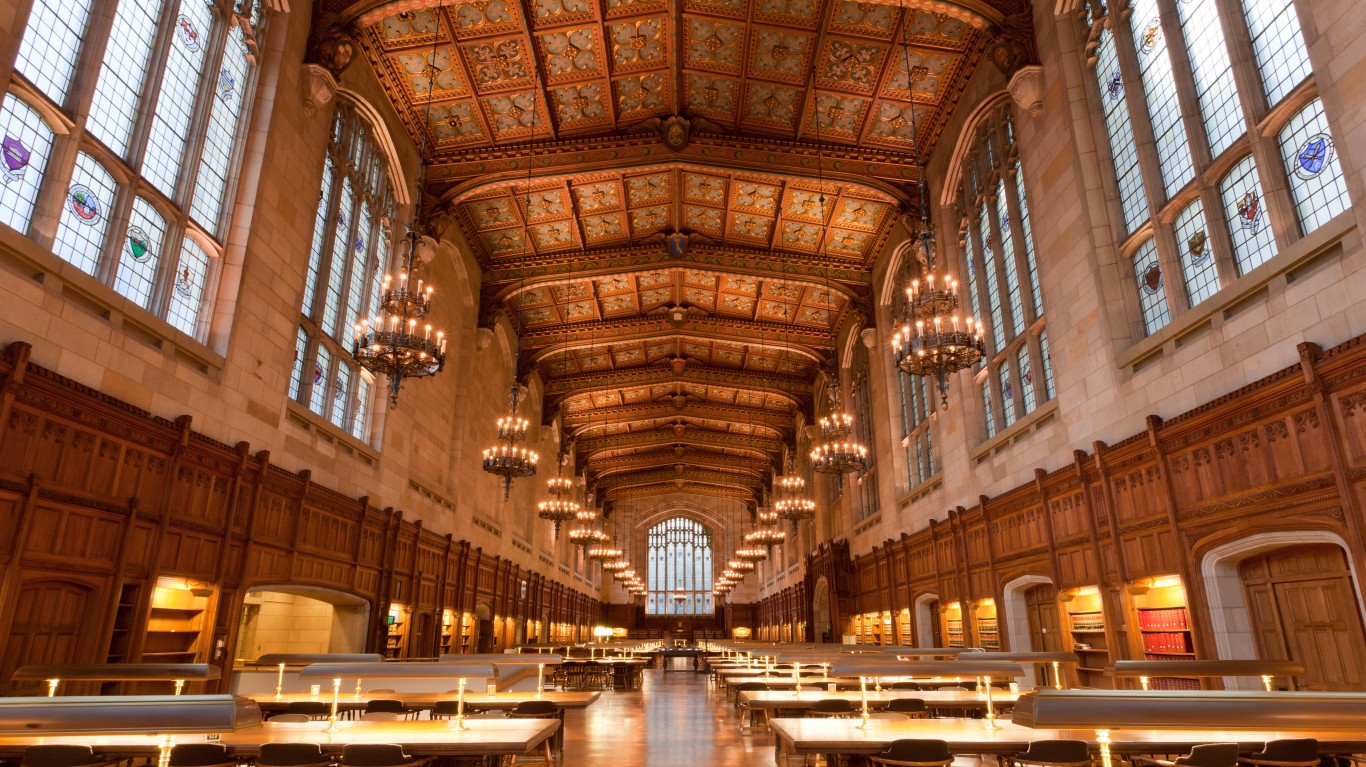
7. University of Michigan Law School
> Acceptance rate: 16.6%
> Total 2019 applications: 5,629
> Median undergraduate GPA, first year class: 3.81
> Median LSAT score, first year class: 169
> Bar passage rate: 95.4%
University of Michigan Law School is one of just two public schools that are home to one of the 10 hardest law schools to get into. fewer than 1,000 of the 5,629 applicants for the fall of 2019 were admitted to the school. Its 2018 graduates had the second lowest unemployment rate of any law school class a year after graduating, at 0.3%.
[in-text-ad-2]
6. Columbia Law School
> Acceptance rate: 15.9%
> Total 2019 applications: 7,193
> Median undergraduate GPA, first year class: 3.80
> Median LSAT score, first year class: 172
> Bar passage rate: 95.1%
Columbia Law School is one of three law schools in New York City to rank among the hardest to get into. It is also one of four Ivy League schools to rank among the 10 most difficult to get into. Though the median undergraduate GPA among first year undergraduates ranks 15th, at 3.80, the median LSAT score of 172 out of 180 ranks third in the nation, behind Harvard and Yale. More than 95% of first-time bar exam takers in 2019 from Columbia Law School passed the test.
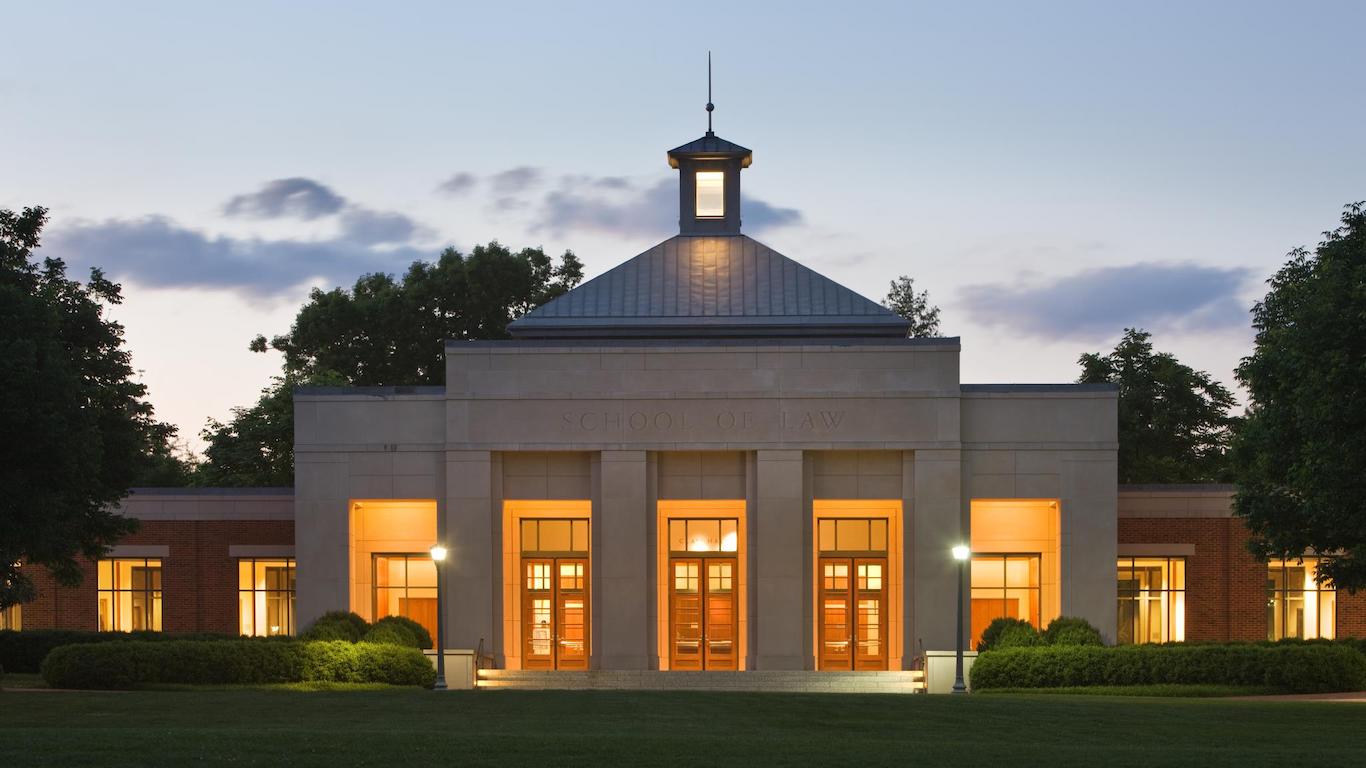
5. University of Virginia School of Law
> Acceptance rate: 14.7%
> Total 2019 applications: 5,645
> Median undergraduate GPA, first year class: 3.90
> Median LSAT score, first year class: 170
> Bar passage rate: 95.8%
The University of Virginia School of Law is the only public university law school to rank among the five hardest to get into. Its fall 2019 first-year class had a median undergraduate GPA of 3.90 and a median LSAT of 170 out of 180 — both in the top five in the nation. The class of 2018 reported an unemployment rate of just 0.3% the year after graduating, the lowest of any accredited law school in the nation.
[in-text-ad]
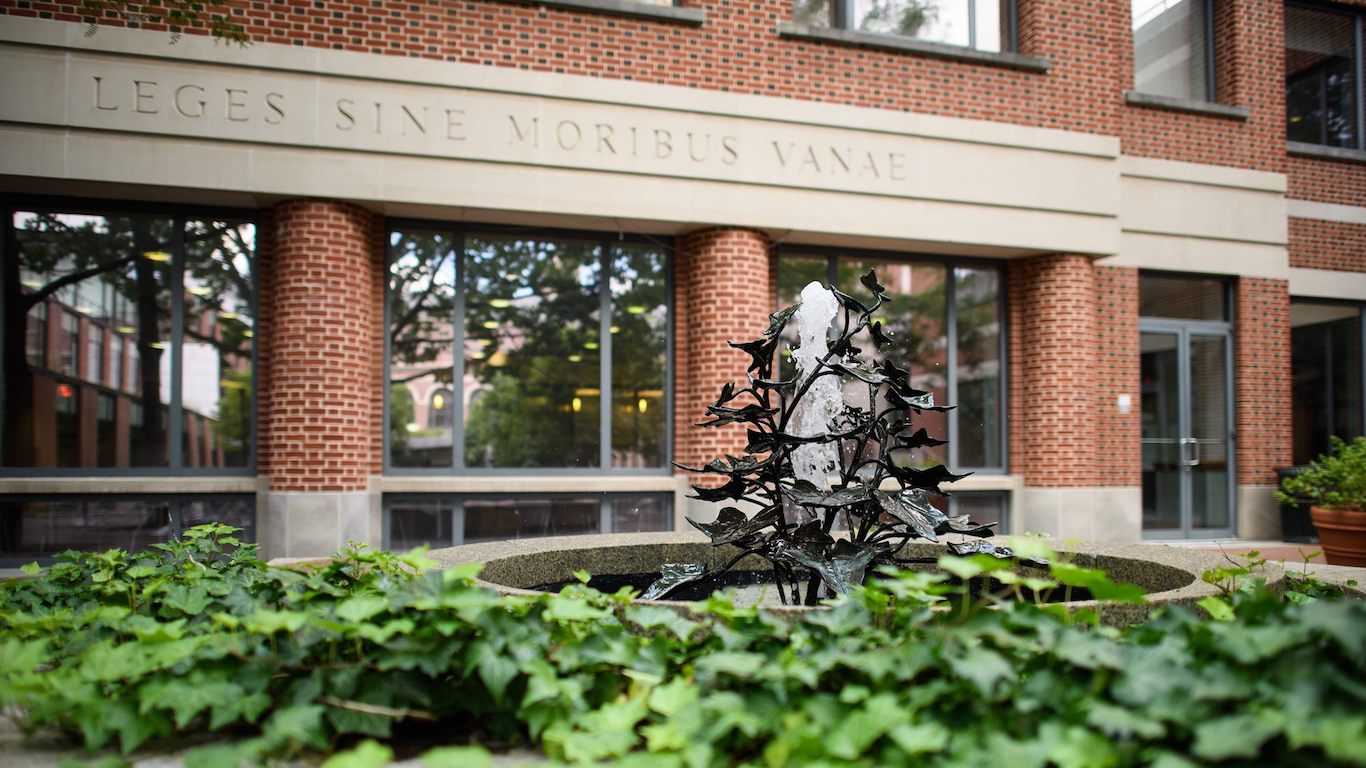
4. University of Pennsylvania Carey Law School
> Acceptance rate: 14.5%
> Total 2019 applications: 6,483
> Median undergraduate GPA, first year class: 3.89
> Median LSAT score, first year class: 170
> Bar passage rate: 97.1%
University of Pennsylvania Carey Law School is one of just five American law schools to admit fewer than 15% of applicants for its fall 2019 class. It is also one of six law schools in which at least half of the first-year class that semester had an LSAT score of 170 or higher. Graduates of the Carey Law School tend to be prepared for the bar exam and beyond — its 97.1% bar passage rate among first-time takers in 2019 was the fifth highest. Also, its class of 2018 had an unemployment rate of just 0.4%, the third lowest among all accredited U.S. law schools.
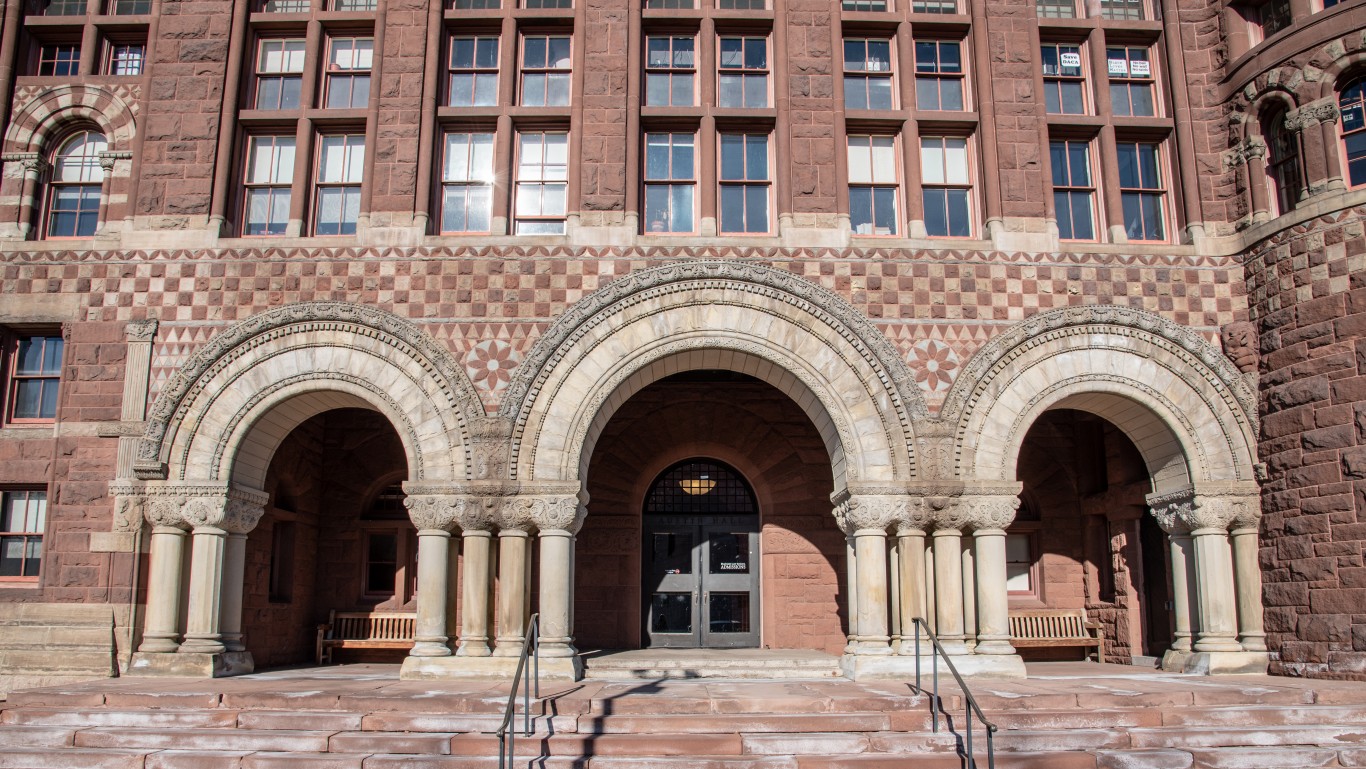
3. Harvard Law School
> Acceptance rate: 12.5%
> Total 2019 applications: 7,333
> Median undergraduate GPA, first year class: 3.89
> Median LSAT score, first year class: 173
> Bar passage rate: 98.9%
Harvard Law School admitted fewer than 1,000 of the 7,333 applicants for its fall 2019 class. Harvard tied with its rival school Yale for the highest median LSAT score among its 2019 first year class, at 173. It reported a 98.9% bar passage rate among first-time takers in 2019, the highest percentage for any school outside of Wisconsin, the only state that allows law school graduates to secure a license to practice law without taking a bar exam. Of the 561 first-time bar exam takers, just six did not pass.
2. Stanford Law School
> Acceptance rate: 9.7%
> Total 2019 applications: 3,908
> Median undergraduate GPA, first year class: 3.91
> Median LSAT score, first year class: 171
> Bar passage rate: 95.3%
Stanford Law School is one of the most selective in the country and one of only two to admit fewer than 10% of applicants for the fall of 2019. This class ranks second with a 3.91 median undergraduate GPA and fourth with a 171 median LSAT score. More than 95% of Stanford’s first-time bar exam takers in 2019 passed the test. And graduates were almost always able to find work right after finishing school. The class of 2018 had an unemployment rate of just 0.5% the year after graduating.
[in-text-ad-2]
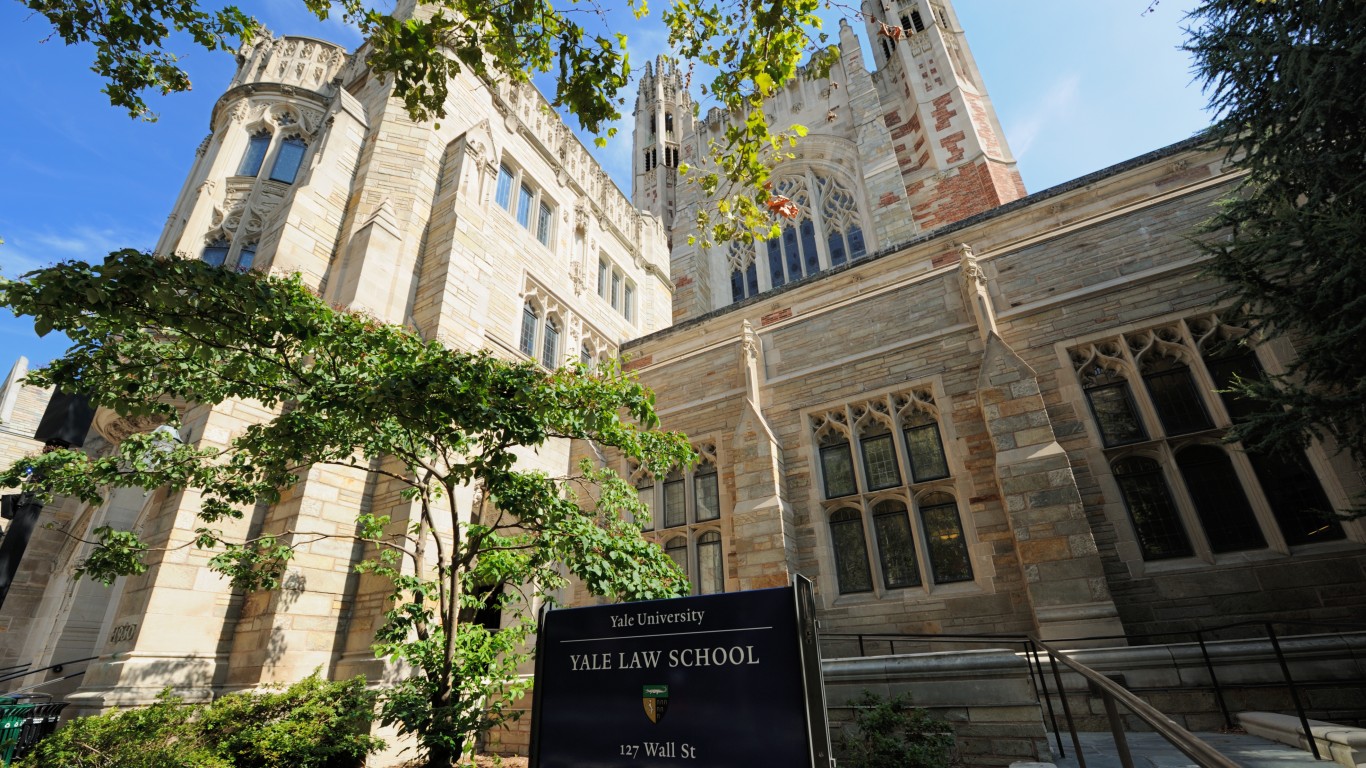
1. Yale Law School
> Acceptance rate: 8.2%
> Total 2019 applications: 3,198
> Median undergraduate GPA, first year class: 3.93
> Median LSAT score, first year class: 173
> Bar passage rate: 96.3%
By every metric, Yale Law School is the hardest to get into in America. Only 263 of its nearly 3,200 applicants for fall 2019 were admitted. This 8.2% admission rate is the lowest of any law school and over a full percentage point lower than the next most selective law school. Its fall 2019 class had the highest undergraduate GPA at 3.93, and the class tied with Harvard’s class for the highest median LSAT score at 173 out of 180. Former presidents Bill Clinton and William Taft attended Yale Law School, as did present Supreme Court justices Samuel Alito and Clarence Thomas.
Credit card companies are at war. The biggest issuers are handing out free rewards and benefits to win the best customers.
It’s possible to find cards paying 1.5%, 2%, and even 5% cash back today. That’s free money for qualified borrowers, and the type of thing that would be crazy to pass up. Those rewards can add up to thousands of dollars every year in free money, and include other benefits as well.
We’ve assembled some of the best credit cards for users today. Or you can jump straight to our top pick today which pays up to 5% cash back, a $200 bonus on top, and $0 annual fee. Click here to apply before they stop offering rewards this generous.
Flywheel Publishing has partnered with CardRatings for our coverage of credit card products. Flywheel Publishing and CardRatings may receive a commission from card issuers.
Thank you for reading! Have some feedback for us?
Contact the 24/7 Wall St. editorial team.